Yarn
Feline Yarn Mishap: What Happened to the Cat?
Discover the fate of a curious feline after a yarn ingestion mishap and learn about the risks and necessary emergency care for cats.

Feline Yarn Mishap: What Happened to the Cat?
Yarn ingestion in cats can pose several risks to their health. The cat health risk yarn ingestion can potentially cause a blockage or obstruction within their digestive tract. This can lead to symptoms such as vomiting, loss of appetite, and lethargy. Immediate veterinary treatment is necessary to veterinary treatment for cat swallowed yarn remove the yarn and address any complications that may arise.
Symptoms of Yarn Blockage
If a cat has swallowed a ball of yarn, it may exhibit various symptoms indicating a potential blockage. Recognizing these symptoms is crucial for identifying the problem and taking immediate action to ensure the cat’s well-being.
- Vomiting: Cats that have ingested yarn may vomit frequently. The presence of undigested yarn in the vomit is a clear indication of a blockage.
- Constipation: Yarn can cause constipation in cats, leading to difficulty in passing stools or infrequent bowel movements.
- Diarrhea: In some cases, cats may experience diarrhea as the body tries to expel the foreign object. Diarrhea with strands of yarn is a concerning symptom.
- Abdominal pain: Cats experiencing a yarn blockage may show signs of discomfort and tenderness in the abdomen. They may be restless, display hunched posture, or exhibit discomfort when touched.
- Lack of appetite: A cat with a yarn blockage may lose its appetite, refusing to eat or drink. It’s essential to monitor their food and water intake closely.
If you notice any of these symptoms in your cat, it’s crucial to seek emergency care immediately. Delaying treatment can lead to further complications and worsen the cat’s condition. Time is of the essence when it comes to addressing yarn ingestion incidents.
Seeing the distressing symptoms your cat is experiencing can be overwhelming, but it’s important to remain calm and focus on getting them the help they need. Remember, prompt action can make a significant difference in their recovery.
Emergency Veterinary Treatment
When a cat has swallowed yarn, immediate veterinary treatment is necessary to address the situation. As soon as you notice your cat swallowing yarn, it’s important to contact your veterinarian or local veterinary emergency clinic for guidance and to schedule an appointment.
The veterinarian will assess the situation and may perform an X-ray or ultrasound to determine the location and severity of the yarn ingestion. This diagnostic imaging helps the veterinarian visualize the extent of the issue and plan the appropriate treatment.
Depending on the specific circumstances, treatment options can include endoscopy or surgery to remove the swallowed yarn from the cat’s digestive tract.
“Immediate veterinary involvement is crucial when it comes to feline emergency yarn consumption. Timely diagnosis and intervention can save a cat’s life.” – Dr. Emily Thompson, DVM
Endoscopy involves the use of a long, flexible tube equipped with a camera and surgical instruments. This minimally invasive procedure allows the veterinarian to navigate the cat’s digestive tract and retrieve the yarn without the need for open surgery.
In more complex cases or if the yarn has caused complications like a blockage or perforation, surgical intervention may be necessary. During surgery, the veterinarian will perform an abdominal incision to directly access and remove the yarn.
Treatment for Infection and Recovery Support
In addition to removing the swallowed yarn, the veterinarian may prescribe antibiotics to prevent infection and support the cat’s recovery. It’s important to administer any prescribed medications as directed and monitor your cat’s progress closely.
During the recovery period, your cat may require supportive care and monitoring. This can involve providing a special diet and ensuring they receive adequate fluids and rest. Follow the veterinarian’s instructions carefully to optimize your cat’s healing process and overall well-being.
Remember, every case of feline emergency yarn consumption can vary, so follow the guidance of your veterinarian for the most appropriate treatment plan.
Potential Complications
When it comes to yarn ingestion in cats, prompt action is crucial to prevent potential complications. If a cat swallows yarn and it remains untreated, several serious issues can arise, including:
- Intestinal Blockages: Yarn can become tangled within the cat’s digestive tract, leading to blockages that obstruct the normal movement of food and waste. This can result in severe discomfort, pain, and vomiting.
- Perforations: The sharp edges of yarn or the cat’s attempts to pass it through their system can cause perforations in the gastrointestinal tract. This can lead to leakage of digestive fluids into the abdominal cavity, triggering a potentially life-threatening condition.
- Peritonitis: Inflammation of the abdominal lining, known as peritonitis, can occur if the gastrointestinal tract becomes perforated. This condition can cause severe pain, fever, and further complications if left untreated.
To illustrate the potential complications of cat swallowing yarn, consider the following table:
| Complication | Clinical Presentation | Treatment |
|---|---|---|
| Intestinal Blockage | Vomiting, abdominal pain, constipation, loss of appetite | Surgical removal of the blockage, supportive care |
| Perforations | Abdominal pain, fever, decreased appetite, lethargy | Surgery to repair perforations, antibiotics, and supportive care |
| Peritonitis | Severe abdominal pain, fever, distended abdomen | Surgical intervention, antibiotics, fluid therapy, and supportive care |
As you can see, the consequences of cat swallowing yarn can be severe and require immediate veterinary intervention. It’s essential to be aware of the potential risks and seek veterinary treatment to minimize these complications and ensure the well-being of your feline companion.
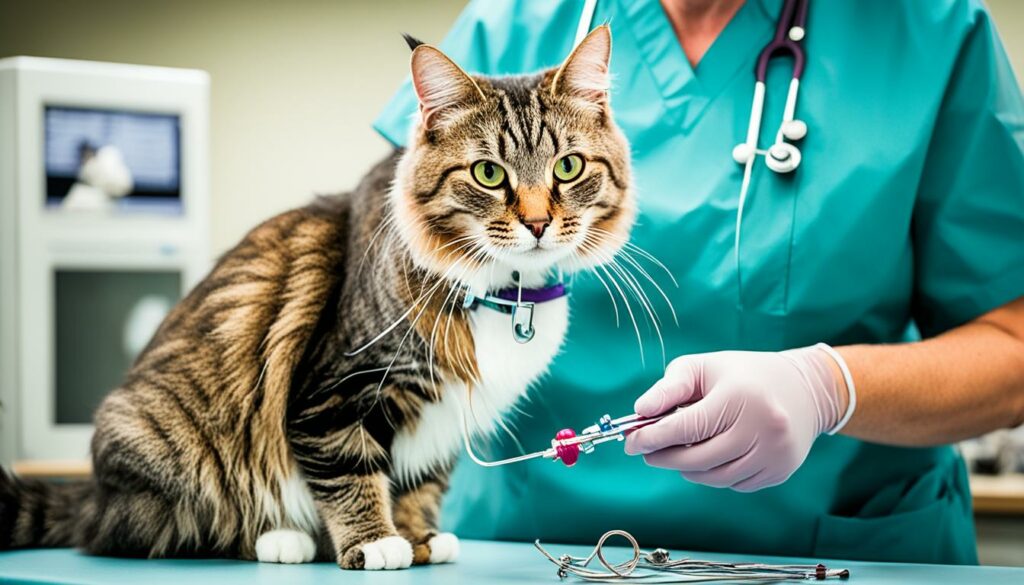
Prevention Strategies
To prevent cats from ingesting yarn, there are several measures you can take to cat-proof your home and eliminate potential hazards. By implementing these strategies, you can ensure your feline friend’s safety and protect them from the health risks associated with yarn ingestion.
Create a Safe Environment
Start by storing yarn and other small objects securely, out of your cat’s reach. Keep them in closed containers or cabinets to prevent curious paws from accessing them. It’s important to note that cats can be remarkably agile, so choose storage solutions that are not easily accessible or knockable.
Remember, prevention is key when it comes to protecting your cat from yarn ingestion. Taking proactive steps to minimize the risk is crucial for their well-being.
Engage in Interactive Play
Cats are naturally curious and playful creatures. By providing them with appropriate toys and engaging in regular interactive playtime sessions, you can redirect their curiosity away from potentially dangerous materials like yarn. Interactive toys, such as wand toys or puzzle feeders, can keep your cat mentally stimulated and satisfy their hunting instincts.
Supervise and Monitor
Even with precautions in place, it’s essential to supervise your cat and monitor their behavior. By keeping a close eye on them, you can quickly intervene if they show any interest in yarn or other hazardous objects. Redirect their attention to their designated toys and reward them for playing with safe alternatives.
Install Physical Barriers
Installing physical barriers can be an effective way to prevent your cat from accessing yarn or other materials that pose a risk. Use baby gates or close doors to restrict access to certain areas where yarn or craft supplies are stored. Cat-proofing your home with these barriers can provide peace of mind and minimize the chances of yarn ingestion.
Educate Family Members and Visitors
Make sure everyone in your household or anyone who visits your home is aware of the importance of preventing cat yarn ingestion. Educate them about the risks and explain the measures that have been put in place to keep your cat safe. Encourage them to follow the same guidelines and take necessary precautions during their interactions with your feline companion.
Regular Housekeeping
Keep your home clean and tidy to minimize the chances of your cat coming into contact with stray pieces of yarn or other small objects. Regularly vacuum and mop floors, especially in any areas where crafting or knitting activities occur. By maintaining a clean environment, you can reduce the risk of accidental ingestion and ensure your cat’s safety.
Consult with Your Veterinarian
If you have any concerns or questions about preventing cat yarn ingestion, don’t hesitate to consult with your veterinarian. They can provide personalized advice tailored to your cat’s specific needs and help address any potential risks or dangers in your home.
By implementing these prevention strategies, you can minimize the risk of yarn ingestion in your cat and create a safe and cat-friendly environment. Remember, your cat’s well-being is in your hands, so take the necessary steps to protect them from potential hazards.
Other Pet Hazards
While yarn ingestion is commonly associated with cats, it’s important to recognize that other pets can also be at risk. Dogs and other animals may be tempted to swallow yarn or other small objects, leading to similar complications.
As responsible pet owners, we must be aware of these common pet hazards and take proactive measures to ensure the safety and well-being of our furry companions. By understanding the risks and implementing preventative strategies, we can minimize the chances of our pets encountering dangerous substances.
Pet Hazards to Watch Out For
Here are some common pet hazards that all pet owners should be familiar with:
- Yarn and string: Swallowing yarn, string, or thread can lead to serious health issues, such as intestinal blockages or entanglement.
- Household chemicals: Chemicals such as cleaning products or pesticides should be stored securely to prevent accidental ingestion by pets.
- Human medications: Medications should never be accessible to pets, as certain medications can be toxic to animals.
- Toxic plants: Some common houseplants, including lilies, azaleas, and aloe vera, can be poisonous to pets if ingested.
- Sharp objects: Poking hazards, such as needles, pins, or sharp objects, should be kept out of reach of pets.
Preventing Pet Hazards
Protecting our pets from these hazards requires diligence and a commitment to their safety. Here are some preventative measures we can take:
- Secure storage: Store yarn, chemicals, medications, and other potentially hazardous items in cabinets or closets that are inaccessible to pets.
- Supervision: Keep a close eye on pets, especially when they are in unfamiliar environments or around potential hazards.
- Proper disposal: Dispose of trash, including yarn scraps, in secure containers to prevent pets from rummaging through it.
- Plant selection: Choose pet-friendly plants for your home and ensure that toxic plants are kept out of reach.
- Training: Teach your pets commands such as “leave it” to discourage them from investigating and ingesting harmful objects.
By being proactive and implementing these prevention strategies, we can create a safe environment for our pets and minimize the risk of accidents or health complications.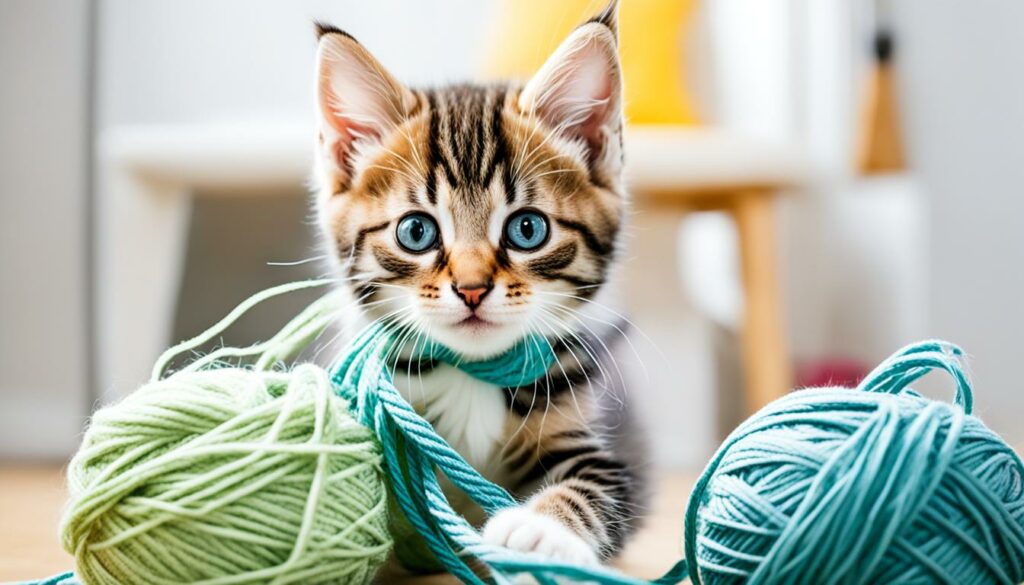
Remember, our pets rely on us to keep them safe. It’s our responsibility to be vigilant, educated, and proactive in reducing the hazards that they may encounter. By doing so, we can ensure that our furry companions lead happy, healthy lives.
Regular Veterinary Check-ups
Regular veterinary check-ups are crucial for the overall health and well-being of our feline friends. These routine visits allow veterinarians to detect any potential health issues early on and provide timely interventions. When it comes to cat health check-ups, preventive care for pets is always the primary focus.
During these check-ups, veterinarians examine cats thoroughly, looking out for any signs of illness or abnormalities. They often assess the cat’s weight, temperature, heart rate, and respiratory rate to gain a comprehensive understanding of their overall health. Additionally, they may conduct blood tests, urine analysis, and other diagnostic procedures to identify any underlying health conditions.
One of the significant benefits of regular cat health check-ups is the opportunity to address gastrointestinal blockages caused by the ingestion of yarn or other foreign objects. These blockages can be life-threatening if not detected and treated early. By detecting any signs of blockages or obstructions, veterinarians can take immediate action to remove the foreign material and prevent further complications.
Preventive Care Measures
In addition to addressing immediate health concerns, regular veterinary check-ups also allow for essential preventive care measures. Vaccinations play a crucial role in maintaining cats’ health by protecting them against various infectious diseases. These vaccinations are administered based on a cat’s age, lifestyle, and risk factors.
Another critical aspect of preventive care during cat health check-ups is parasite control. Parasites, such as fleas, ticks, and worms, can significantly impact a cat’s health and well-being if left untreated. Veterinarians can recommend suitable preventive treatments to protect against these parasites, ensuring our cats stay healthy and happy.
“Regular veterinary check-ups provide a golden opportunity for cat owners to stay vigilant about their pet’s health and catch any potential problems before they escalate.” – Dr. Emily Thompson, DVM
By investing in regular cat health check-ups, we can provide the best possible care for our furry companions. These check-ups not only help us detect and address health issues promptly but also offer valuable guidance and insight into maintaining our cats’ overall well-being.
Pet Insurance and Emergency Situations
When it comes to our beloved pets, we always want to ensure their health and well-being. However, unforeseen emergencies can happen, such as yarn ingestion in cats, which can result in high veterinary expenses. This is where pet insurance for emergency care comes into play, providing financial protection for pet emergencies.
Pet insurance offers coverage for a range of emergency situations, including accidents and illnesses like yarn blockage in cats. It can help ease the financial burden of extensive veterinary treatment, surgeries, medications, and necessary follow-up care.
Why Consider Pet Insurance?
Obtaining pet insurance can provide peace of mind, knowing that you have a safety net in times of unexpected emergencies. It allows you to focus on your pet’s well-being without the added stress of financial strain. With pet insurance, you can rest assured that you can provide your furry companion with the necessary care they need, even in the face of a yarn ingestion incident.
“Pet insurance can provide financial protection and reduce the worry of unexpected veterinary expenses.”
How Pet Insurance Works
Similar to human health insurance, pet insurance typically involves monthly premiums and coverage plans tailored to your pet’s needs. The cost of the premium may vary depending on factors such as your pet’s breed, age, and overall health. It’s important to review different insurance providers and their coverage options to find the best fit for your pet.
In the event of an emergency, you would file a claim with your pet insurance provider, detailing the incurred expenses for yarn ingestion treatment and related care. Depending on your policy, the insurance company will reimburse you for eligible expenses, providing the much-needed financial support during a stressful time.
Choosing the Right Pet Insurance
When selecting pet insurance for emergency care, it’s crucial to consider factors such as coverage limits, deductibles, and waiting periods. Read the policy thoroughly, paying attention to any exclusions or limitations that may affect your pet’s specific needs.
Research different insurance providers, compare plans, and read reviews from other pet owners to make an informed decision. A reputable pet insurance company will have a track record of delivering reliable coverage and excellent customer service.
Take the First Step in Protecting Your Pet
Investing in pet insurance for emergency care is a proactive step in safeguarding the well-being of your furry companion. It allows you to provide the necessary treatment and care for incidents like yarn ingestion without the worry of overwhelming expenses.
Don’t wait for an emergency to strike. Explore your pet insurance options today and give your pet the financial protection they deserve.
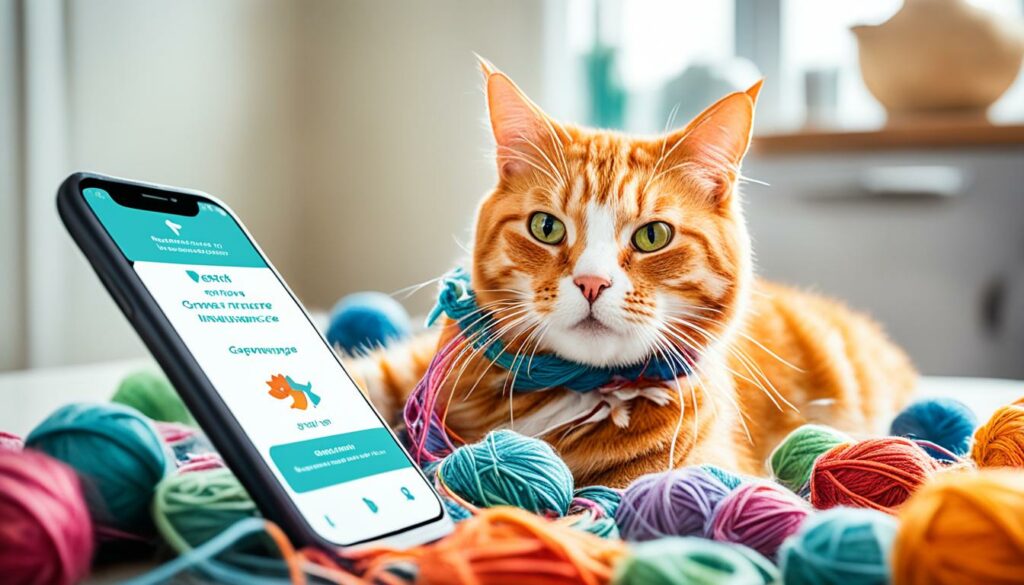
Support and Resources
As pet owners, we understand that facing a yarn ingestion incident with our furry companions can be a stressful and worrisome experience. That’s why it’s crucial to know that you are not alone in navigating this situation. There are various support and resources available to help you through this challenging time.
Online Communities
Connecting with other pet owners who have experienced similar situations can offer invaluable insights and support. Online communities dedicated to pet health and well-being can provide a platform for sharing experiences, asking questions, and receiving advice. You can find comfort in knowing that others have gone through similar challenges and have come out with successful outcomes.
Veterinarian Helplines
Veterinarian helplines can be an excellent resource when you need immediate guidance or have concerns about your pet’s health. These helplines are staffed by knowledgeable veterinary professionals who can provide expert advice and answer your questions. Whether it’s a general inquiry or a specific issue related to yarn ingestion, they can offer reassurance and help you make informed decisions.
Educational Resources
Educational resources, such as articles, guides, and videos, can provide valuable information on how to handle yarn ingestion incidents in pets. These resources often cover topics such as recognizing symptoms, emergency first aid measures, and guidance on when to seek immediate veterinary care. By educating yourself about the potential risks and appropriate actions to take, you can feel more confident in managing the situation.
“Remember, knowledge is power when it comes to your pet’s health. By staying informed and utilizing the available resources, you can provide the best possible care for your furry friend.”
Dealing with a yarn ingestion incident can be overwhelming, but with the right support and resources, you can navigate through it successfully. Reach out to online communities, utilize veterinarian helplines, and educate yourself through reliable sources. Remember that your pet’s health is our top priority, and we are here to support you every step of the way.
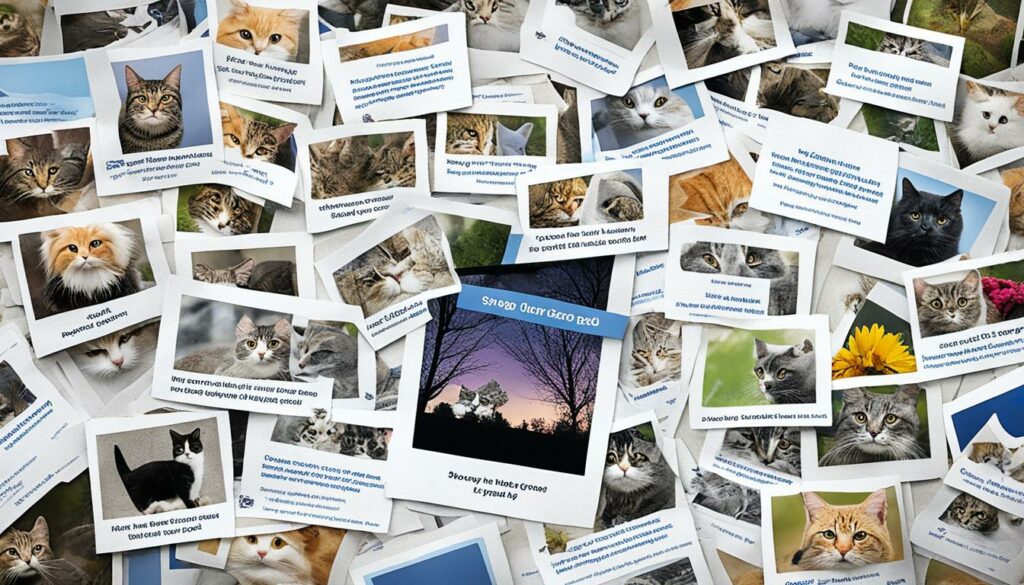
Conclusion
When a cat swallows a ball of yarn, it is crucial to seek immediate veterinary attention to prevent complications and ensure their well-being. Yarn ingestion in cats can lead to serious health risks, including blockages and perforations, that may require surgical intervention.
Taking preventative measures and providing regular veterinary care can help safeguard against such incidents. By being proactive and informed, pet owners can protect their furry companions and promote their overall health and safety.
Remember, a cat’s curiosity knows no bounds, and it’s our responsibility to create a safe environment for our feline friends. Store yarn and other small objects securely, out of their reach. Engage in interactive playtime and provide appropriate toys to redirect their attention away from potentially dangerous materials.
By prioritizing their well-being and staying vigilant, we can prevent the unfortunate incident of a cat swallowing a ball of yarn and ensure their continued happiness and health.FAQ
What are the risks of yarn ingestion in cats?
What are the symptoms of a yarn blockage in cats?
How should I seek emergency care for my cat if it swallows yarn?
What are the potential complications of yarn ingestion in cats?
How can I prevent my cat from ingesting yarn?
Can other pets be at risk of yarn ingestion?
How often should I take my cat for regular veterinary check-ups?
Can pet insurance help cover the costs of emergency care for yarn ingestion?
Where can I find support and resources as a pet owner facing a yarn ingestion incident?
What should I do if my cat swallows a ball of yarn?
Yarn
Yarn for Scarves: How Many Yards Do You Need?
Curious about scarf knitting yardage? Discover how many yards of yarn you need for a scarf to start your project with confidence.
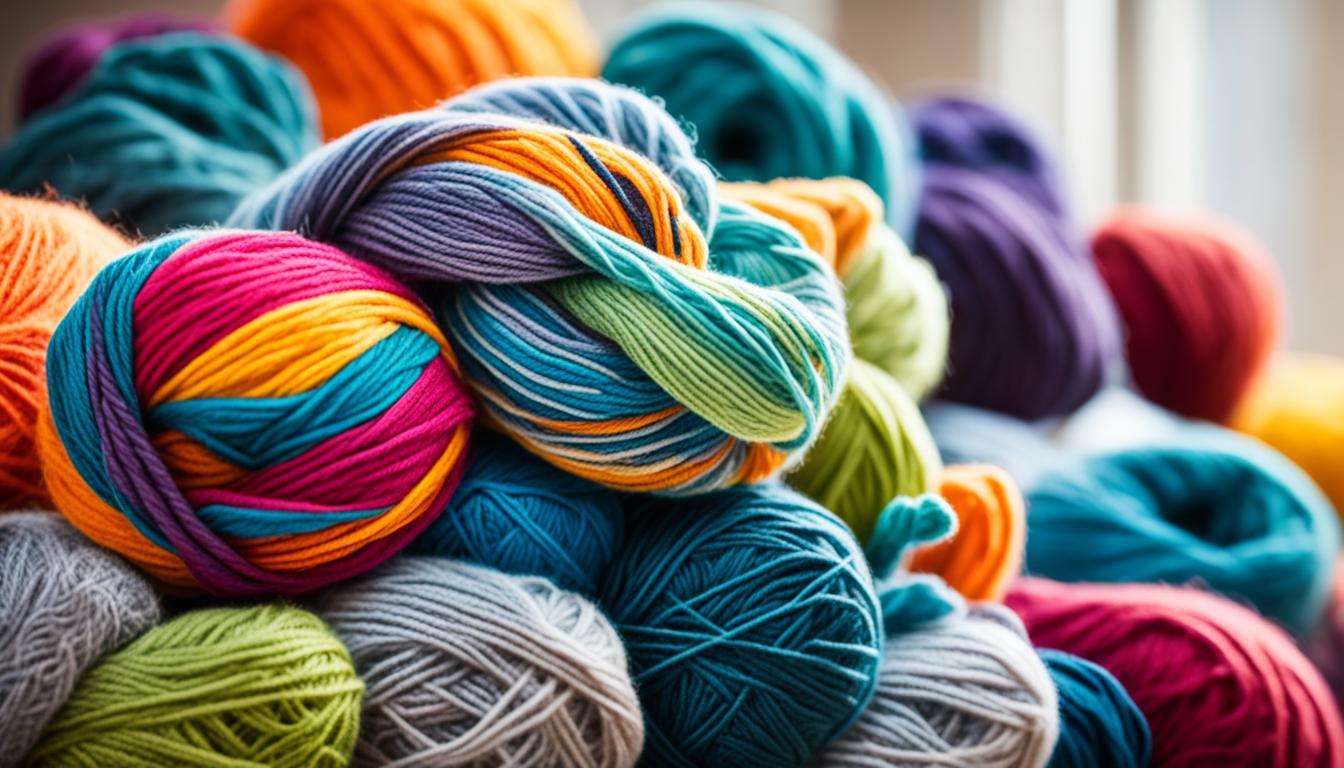
Scarves are a staple accessory for the winter season, keeping us warm and stylish. But have you ever found yourself puzzled when it comes to figuring out how much yarn you need for a scarf? Fear not! We’ve gathered information from various sources to help you calculate the yardage needed for your scarf knitting project. So, whether you’re a beginner or an experienced knitter, join us as we unravel the mystery of yarn requirements for scarves.
Key Takeaways:
- Calculating the yardage for a scarf involves considering factors such as width, length, and texture.
- Understanding yarn weight and yardage is crucial in estimating the amount of yarn needed for a scarf.
- A gauge swatch helps determine the number of stitches and rows per inch, leading to a more precise estimation of yarn requirements.
- Factors like the depth of texture, yarn density, and modifications to the pattern can affect the overall yardage.
- Buying a little extra yarn, using leftover yarn creatively, and considering recommended scarf lengths and widths can optimize your yarn usage.
Understanding Yarn Weight and Yardage
The weight of the yarn is a crucial factor when estimating the yardage required for your scarf knitting project. Different yarn weights will dictate the amount of yardage needed, so it’s essential to refer to a yarn weight chart or the information provided on the yarn label. This will give you a better understanding of the estimated yardage for each weight category.
Lighter yarn weights generally require fewer yards, while heavier weights may necessitate more yardage for the same scarf dimensions. It’s important to consider this variation when calculating the amount of yarn you’ll need for your project.
Calculating Yarn Requirements with Gauge Swatch
When it comes to knitting a scarf, accurately calculating the yardage needed is crucial for a successful project. To achieve this, we recommend creating a gauge swatch. This small sample of knitting helps determine the number of stitches and rows per inch, allowing you to estimate the total yardage required for your desired scarf size. By taking into account your knitting tension and stitch pattern, you can achieve a more precise yarn measurement.
Here’s how to calculate yarn needs using a gauge swatch:
- Start by knitting a small swatch using the same yarn and needle size you plan to use for your scarf.
- Measure the swatch’s width and height, ensuring it’s flat and not stretched. This will give you the number of stitches and rows per inch.
- Determine the desired width and length of your scarf.
- Multiply the number of stitches per inch by the desired width to calculate the total number of stitches needed.
- Multiply the number of rows per inch by the desired length to calculate the total number of rows needed.
- Using the yarn weight and yardage information on the label, estimate the number of yards required per stitch and per row.
- Finally, multiply the total number of stitches by the number of yards per stitch, and multiply the total number of rows by the number of yards per row. Add these two results together to determine the total yardage needed for your scarf.
Calculating yarn requirements with a gauge swatch ensures you have a more accurate estimate, taking into account your unique knitting tension and stitch pattern. This helps prevent the frustration of running out of yarn or having excess leftovers.
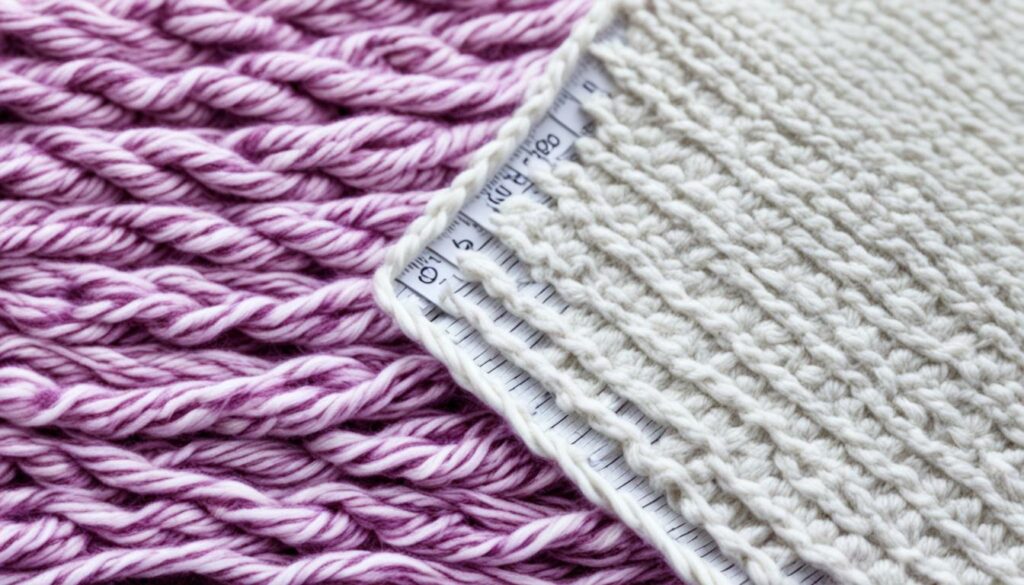
Now that you know how to calculate yarn needs using a gauge swatch, you can confidently start your scarf knitting project. In the next section, we will explore the various factors that can affect the quantity of yarn needed for a scarf.
Factors Affecting Yarn Quantity
When estimating the yardage needed for a scarf, it’s important to consider various factors that can influence the overall quantity of yarn required. These factors include:
- The width and length of the scarf: A wider or longer scarf will naturally require more yarn. This is because the dimensions of the scarf directly contribute to the total surface area that needs to be covered. Therefore, the larger the dimensions, the more yardage will be needed.
- The depth of texture: Adding unique textures to your scarf, such as cables or intricate stitch patterns, can impact the amount of yarn used. These textured elements require more yarn to create the desired effect. So, if you plan on incorporating complex stitch patterns or rich texture in your scarf, be prepared to increase the estimated yardage accordingly.
- The density of the yarn: The density of the yarn, which refers to its thickness and weight, can also affect the yardage needed. Yarns with higher density will require fewer yards to cover the same area compared to lighter-weight yarns. So, if you’re working with a denser yarn, you might need less yardage to achieve the desired size and thickness of your scarf.
To summarize, factors such as the width and length of the scarf, the depth of texture, and the density of the yarn can all influence the total yardage needed for your next scarf-knitting project. Considering these factors and making appropriate adjustments to your estimates will ensure that you have enough yarn to complete your scarf without running out in the middle of your knitting journey.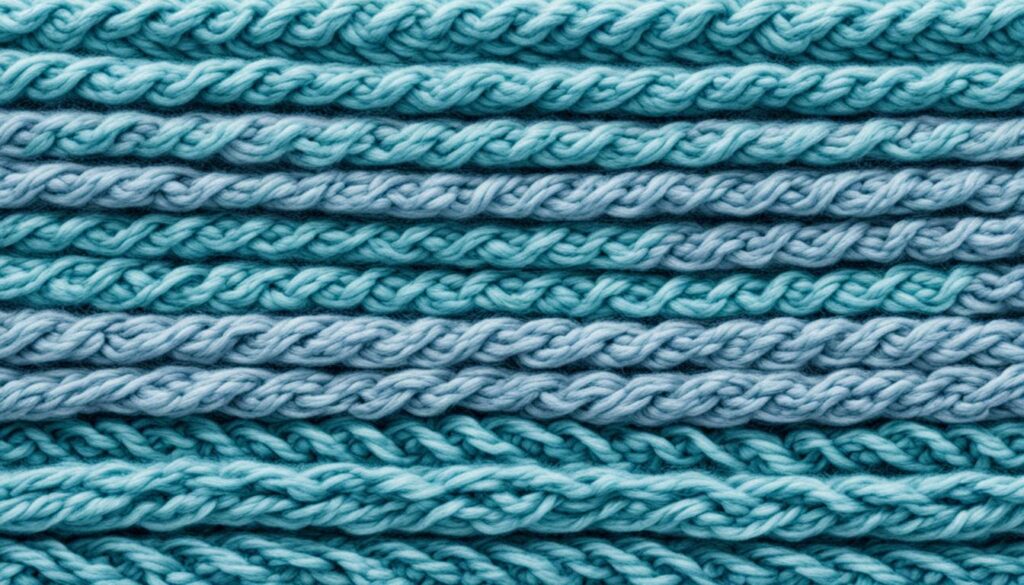
Examples of Yardage Requirements for Scarves
When it comes to knitting scarves, knowing the yardage requirements is crucial to ensure you have enough yarn for your project. To give you a clearer idea of the amount of yarn needed, here are some examples based on specific patterns and measurements:
Example 1: Ribbed Scarf
This simple ribbed scarf pattern calls for 400 yards of worsted weight yarn. With its classic design and versatile style, this scarf is a staple for any winter wardrobe. Knitting it with a cozy yarn will keep you warm and stylish all season long.
Example 2: Lace Infinity Scarf
If you’re looking for a dainty and feminine scarf, a lace infinity scarf is a perfect choice. For this pattern, you’ll need approximately 600 yards of lace weight yarn to achieve the delicate and intricate lacework. The lightweight yarn ensures a soft and airy feel, making it ideal for transitional seasons.
Example 3: Chunky Cable Scarf
For a chunky and cozy scarf that makes a statement, a cable pattern is a great option. This cable scarf requires around 800 yards of bulky weight yarn to showcase the intricate cable design. The thick yarn creates a warm and substantial accessory, perfect for braving the cold winter days.
While these examples provide a reference point, it’s important to keep in mind that individual knitting tension and stitch patterns may slightly alter the yardage requirements. As such, we recommend having more yarn on hand than calculated to account for any variations or modifications you may make to the pattern.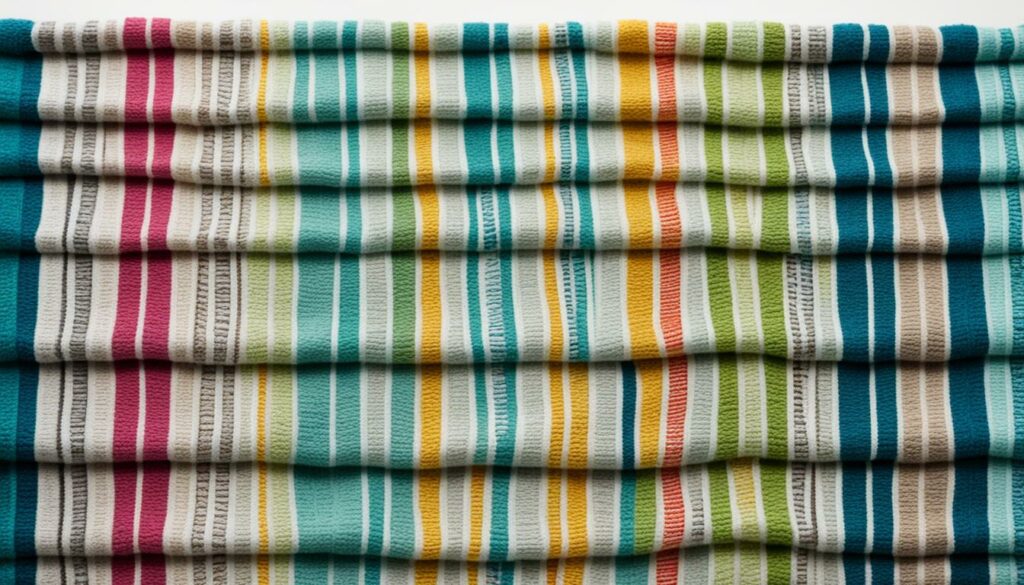
| Scarf Pattern | Yarn Weight | Yardage |
|---|---|---|
| Ribbed Scarf | Worsted | 400 yards |
| Lace Infinity Scarf | Lace | 600 yards |
| Chunky Cable Scarf | Bulky | 800 yards |
Adjusting Yardage for Pattern Variations
If you decide to modify a scarf pattern, whether it’s by changing the width, length, or adding more texture, it’s important to adjust the yardage accordingly. Depending on the specific modifications, you may need to increase or decrease the estimated yardage. To ensure you have enough yarn for your project, always consider the planned modifications and refer back to the original calculation methods.
When making pattern variations such as widening or narrowing the width, keep in mind that a wider scarf will require more yarn, while a narrower one will generally need less. You can estimate the additional or reduced yardage by calculating the difference in width and adjusting it proportionally.
The same applies to modifications in length. If you’re planning to make a longer scarf, you’ll need more yarn, while a shorter scarf will require less. Measure the desired length and compare it to the original pattern to determine the additional or reduced yardage.
Adding more texture, such as cables or lace patterns, can also affect the yardage needed for your scarf. Stitch patterns with a higher level of complexity may consume more yarn. Consider the stitch repeat and the number of rows or rounds needed to achieve the desired texture. You may want to create a gauge swatch with the pattern variation to calculate the yardage more accurately.
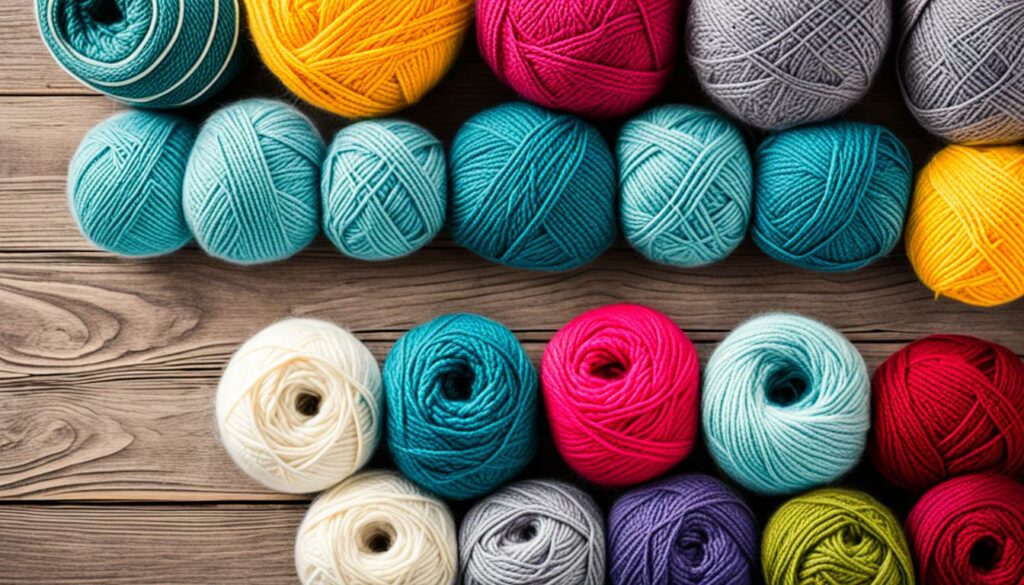
By adjusting the yardage for pattern variations, you can ensure that you have enough yarn to complete your modified scarf. It’s always better to have a little extra yarn than to run out in the middle of your project. Take your time to calculate the yardage needed for your specific modifications and enjoy the process of creating a unique and personalized scarf.
Tips for Buying Yarn for Scarves
When it comes to buying yarn for your scarf projects, we have a few helpful tips to ensure a smooth and successful knitting experience. By following these yarn purchasing tips, you can avoid running out of yarn or encountering any unexpected surprises along the way.
Buy a Little More Than the Estimated Yardage
It’s always a good idea to purchase a little extra yarn than the estimated yardage for your scarf. This allows for any variations in knitting tension or if you decide to make modifications to the pattern. Having a bit of extra yarn ensures that you have enough to complete your project without having to worry about running out.
Consider the Fiber Content
When choosing yarn for your scarf, it’s important to consider the fiber content. Different fibers may have different yardage requirements. For example, bulky wool yarn may require less yardage compared to a finer silk yarn. Take a look at the yarn label or consult with your local yarn shop for guidance on the yardage needed based on the specific fiber content you choose.
Check the Dye Lot and Purchase Enough Skeins
Before purchasing yarn for your scarf, it’s crucial to check the dye lot. Dye lots represent the batch in which the yarn was dyed, and slight color variations can occur between different dye lots. To ensure a consistent color throughout your scarf, make sure to purchase enough skeins or balls of yarn from the same dye lot. This helps prevent any noticeable color differences in your finished project.
Remember, buying yarn for your scarf is more than just a shopping task. It’s an exciting opportunity to explore different fibers, textures, and colors to bring your knitting project to life. By applying these tips, you can confidently choose the right yarn, have enough supply, and create a beautiful and cozy scarf that you’ll cherish for years to come.
Making the Most of Your Yarn
When it comes to knitting a scarf, maximizing yarn usage and using leftover yarn is a great way to get creative and reduce waste. By exploring alternate stitch patterns or designs that require less yardage, you can make the most out of every skein of yarn. Additionally, incorporating leftover yarn from other projects can add beautiful stripes or color-block patterns to your scarf.
One technique to consider is alternating between different colors or textures to create a visually appealing and unique scarf. This allows you to use up smaller quantities of leftover yarn while still achieving a stunning result. Whether you choose to combine complementary colors or experiment with contrasting textures, the possibilities are endless!
Another way to maximize yarn usage is to choose stitch patterns that are known for their efficiency. For example, opting for lacework or openwork designs can create a beautifully textured scarf while using less yarn compared to denser stitch patterns.
Embracing Stripes and Color Blocks
Stripes and color blocks are a fantastic way to incorporate leftover yarn into your scarf. By alternating between different colors or even textures, you can create visually striking patterns that catch the eye. Whether you prefer bold and vibrant stripes or subtle and tonal color blocks, this technique allows you to use up smaller quantities of leftover yarn while adding a touch of uniqueness to your scarf.
“Using leftover yarn to add stripes or color blocks not only maximizes yarn usage but also adds a personal touch to your scarf.” – Knitting Enthusiast
Creating a Scrap Yarn Scarf
If you have various oddments of yarn leftover from different projects, why not create a beautiful scrap yarn scarf? This is a fantastic way to combine different colors, textures, and even weights of yarn to make a truly one-of-a-kind piece. Using a simple garter stitch or a basic ribbing pattern, you can seamlessly blend the different yarns together to create a visually interesting and textured scarf.
Demo for Maximizing Yarn Usage
To demonstrate how you can maximize yarn usage and incorporate leftover yarn into your scarf, take a look at this table showcasing different stitch patterns and their estimated yardage:
| Stitch Pattern | Yardage per Inch |
|---|---|
| Garter Stitch | 10 yards |
| Stockinette Stitch | 12 yards |
| Lacework | 8 yards |
| Ribbing | 10 yards |
As shown in the table, opting for stitch patterns like lacework or ribbing can help you achieve a beautiful scarf while using less yarn per inch compared to garter stitch or stockinette stitch. This means you can stretch your yarn further, making it possible to create longer scarves or even use up smaller amounts of leftover yarn.
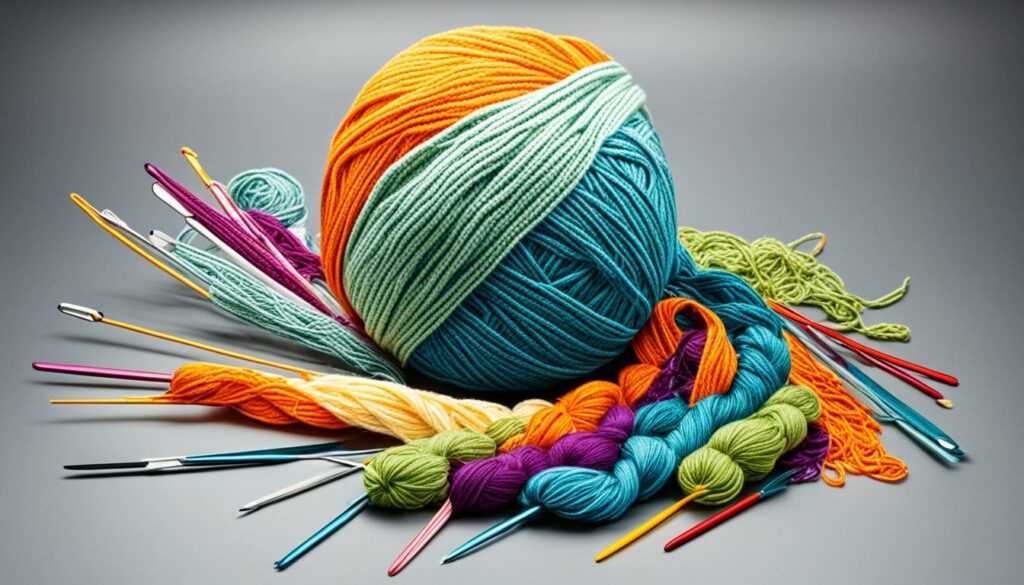
Recommended Scarf Lengths and Widths
The length and width of a scarf are important factors to consider when knitting to ensure both functionality and style. Personal preference and intended use play a significant role in determining the ideal scarf length and width. Here are some recommendations to guide you:
Scarf Length
A standard scarf length typically falls within the range of 60-70 inches. This length allows for versatility in styling, as it can be wrapped around the neck multiple times or left long for a more relaxed look. However, shorter scarves around 50-55 inches in length are also popular for a neat and tidy appearance.
Scarf Width
The width of a scarf can vary depending on individual preference and the desired level of coverage. For a narrower scarf, a width of 6-8 inches is suitable, providing a sleek and lightweight accessory. On the other hand, wider scarves ranging from 10-12 inches offer more warmth and can make a bold fashion statement.
Remember, the length and width of your scarf should be proportionate to your body size and the intended coverage. It’s essential to consider these factors to ensure your scarf not only looks great but also keeps you warm and comfortable.
Now that you have a better understanding of the recommended scarf lengths and widths, you can confidently choose the dimensions that best suit your style and knitting project. Experiment with different lengths and widths to create unique scarves that reflect your personality and meet your specific needs.
| Scarf Length | Scarf Width |
|---|---|
| 50-55 inches | 6-8 inches |
| 60-70 inches | 10-12 inches |
Conclusion
Knitting a scarf can be a fun and rewarding project, but accurately estimating the yardage needed is essential to ensure the successful completion of your scarf. By considering factors such as yarn weight, gauge swatching, and pattern modifications, you can confidently determine the amount of yarn required for your project. Remember to always have a little extra yarn on hand and get creative with any leftover yarn. With the right planning and calculations, you can knit a beautiful scarf that is both stylish and warm.
Summarizing scarf yarn requirements, the key factors to consider are yarn weight, gauge swatching, and pattern modifications. Yarn weight plays a crucial role in determining the amount of yardage needed, with lighter weights requiring less yarn and heavier weights requiring more. Creating a gauge swatch allows you to accurately calculate the number of stitches and rows per inch, resulting in a more precise yarn measurement. Additionally, adjusting yardage for pattern variations and having extra yarn on hand can help you tackle any unexpected modifications and ensure a successful scarf knitting project.
Final thoughts on scarf knitting, remember to enjoy the process and have fun experimenting with different yarns and patterns. Knitting a scarf allows you to express your creativity and create a unique accessory that reflects your personal style. Whether you’re a beginner or an experienced knitter, taking the time to accurately estimate your yarn requirements will enhance your overall knitting experience and result in a beautifully crafted scarf that you can proudly wear or gift to a loved one.
FAQ
How do I determine how much yarn I need for a scarf?
What role does yarn weight play in determining the yardage needed for a scarf?
How can I calculate yarn requirements using a gauge swatch?
What factors can affect the yardage needed for a scarf?
Can you provide examples of yardage requirements for different types of scarves?
How should I adjust the yardage if I modify a scarf pattern?
What should I consider when buying yarn for a scarf project?
How can I make the most of my yarn and prevent wasted leftovers?
What are the recommended lengths and widths for scarves?
Yarn
Unraveling the Cost: Why Does Yarn Cost So Much?
Explore the complexities behind high yarn prices and learn why yarn costs so much. Dive into yarn pricing factors with us!
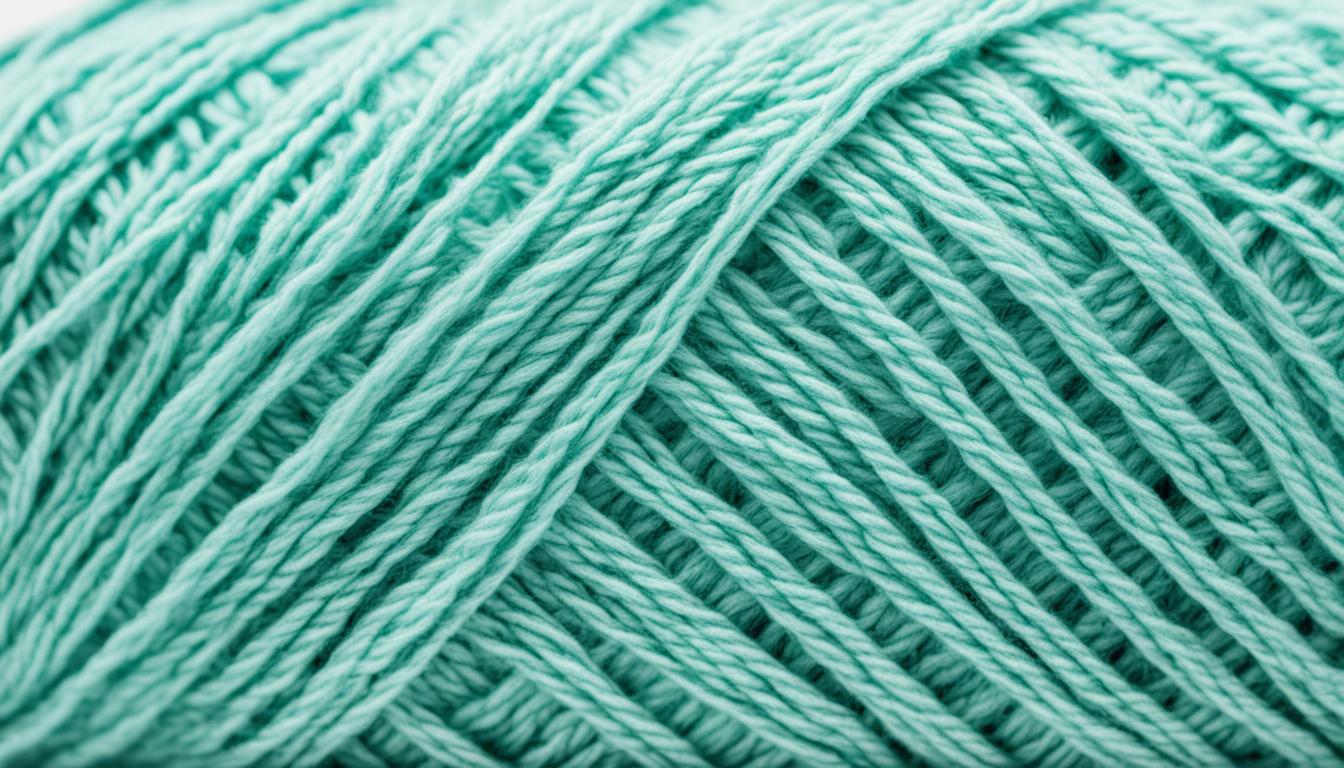
Have you ever wondered why yarn seems to come with a hefty price tag? Whether you’re an avid knitter or someone who enjoys the cozy warmth of a handmade sweater, understanding the factors that contribute to yarn pricing is essential. From the cost of materials to the impact of inflation, there are various elements that unravel the mystery behind yarn’s expense.
In this article, we will delve into the factors that influence yarn prices, providing insights into the yarn industry’s pricing dynamics. By unraveling the cost, we aim to shed light on why yarn comes with a higher price compared to other materials and challenge common beliefs surrounding the price of yarn.
Key Takeaways:
- Understanding the factors that contribute to yarn pricing empowers consumers to make informed decisions about purchasing yarn.
- Inflation, supply and demand, material quality, and production methods all play a role in determining the cost of yarn.
- Yarn prices can vary based on factors such as weight, thickness, and the type of materials used.
- Recycled and sustainable yarn options are gaining popularity as the demand for environmentally friendly products increases.
- By finding a balance between quality and budget, knitters and consumers can make cost-effective choices without compromising on the materials they desire.
The Impact of Inflation on Yarn Prices
Inflation, a term you may have heard before, plays a significant role in determining yarn prices. But what exactly is inflation, and how does it affect the cost of yarn?
Inflation refers to the general increase in prices for goods and services over time. When inflation occurs, the purchasing power of money decreases, meaning that the same amount of money can buy fewer items than before. This decrease in purchasing power affects all sectors of the economy, including the yarn industry.
As the cost of production rises, due to factors such as raw material expenses and increased labor costs, yarn manufacturers are forced to increase prices to maintain their profitability. These rising costs of goods and services, driven by inflation, are passed on to consumers in the form of higher yarn prices.
This phenomenon can be observed in various aspects of the yarn production process. For example, the cost of raw materials, such as cotton or wool, may increase due to inflationary pressures. Additionally, the rising operating costs of yarn mills or manufacturing facilities can contribute to higher yarn prices.
It’s important to note that inflation doesn’t affect yarn prices in isolation. Instead, it impacts prices across industries, as the increase in costs ripples through the supply chain. Yarn suppliers and retailers, who incur their own overhead expenses, must also adjust their prices to account for inflation and maintain their margins.
Understanding the impact of inflation on yarn prices is crucial for consumers and knitters alike. When prices rise, it’s essential to evaluate the purchasing power of your budget and make informed decisions about the yarn you choose.
Now that we’ve explored how inflation affects yarn prices, let’s delve deeper into the intricate relationship between supply and demand in the yarn industry.
Supply and Demand in the Yarn Industry
Yarn prices are influenced by the principles of supply and demand. Understanding how these factors interact is essential to grasp the dynamics behind yarn pricing. When consumer demand for yarn increases, suppliers have the opportunity to charge higher prices for their products due to the increased competition among buyers. This rise in demand can be driven by various factors, including seasonal trends, fashion trends, or popular knitting projects.
Conversely, if the demand for yarn decreases, suppliers may need to lower their prices to stimulate sales. This can occur when there is a shift in consumer preferences or when there is an oversupply of yarn in the market. In such situations, yarn suppliers may implement promotional offers or discounts to encourage customers to buy their products. Understanding the relationship between supply and demand is vital for consumers who want to make informed purchasing decisions and find the best prices for the yarn they need.
It’s also important to note that the cost of production plays a crucial role in supply and, subsequently, in pricing. Yarn production involves various expenses, such as raw materials and labor. Fluctuations in the cost of these inputs can impact the supply side of the equation, leading to changes in yarn prices. For example, if the price of raw materials, like cotton or wool, increases, yarn suppliers may need to adjust their prices to compensate for the higher production costs.
Finding the Right Yarn Supplier
When looking for yarn suppliers, it’s essential to consider factors beyond just price. While price is an important consideration, the quality of the yarn and the reliability of the supplier are equally crucial. Here are some key factors to keep in mind when choosing a yarn supplier:
- Quality: Look for suppliers that offer high-quality yarns that meet your specific project requirements. This includes considering the fiber content, texture, and color options available.
- Range of Products: Ensure the supplier offers a wide range of yarn types, weights, and colors to cater to diverse knitting needs.
- Customer Reviews: Read customer reviews and testimonials to gauge the satisfaction levels and experiences of other buyers.
- Shipping and Delivery: Consider the supplier’s shipping policies, delivery times, and any additional charges that may apply.
By considering these factors, you can find a reliable yarn supplier who offers the right combination of quality, variety, and competitive pricing.
Remember, balancing price and quality is essential when purchasing yarn. While affordability is important, it’s equally crucial to choose yarn that is suitable for your project and will yield the desired results.
Now that we have explored the influence of supply and demand on yarn prices, let’s take a look at another critical factor: the quality and type of yarn materials.
| Factors Influencing Yarn Prices | Description |
|---|---|
| Supply and Demand | The interaction between consumer demand and yarn production affects pricing. |
| Cost of Production | Expenses incurred during yarn production, including raw materials and labor, impact prices. |
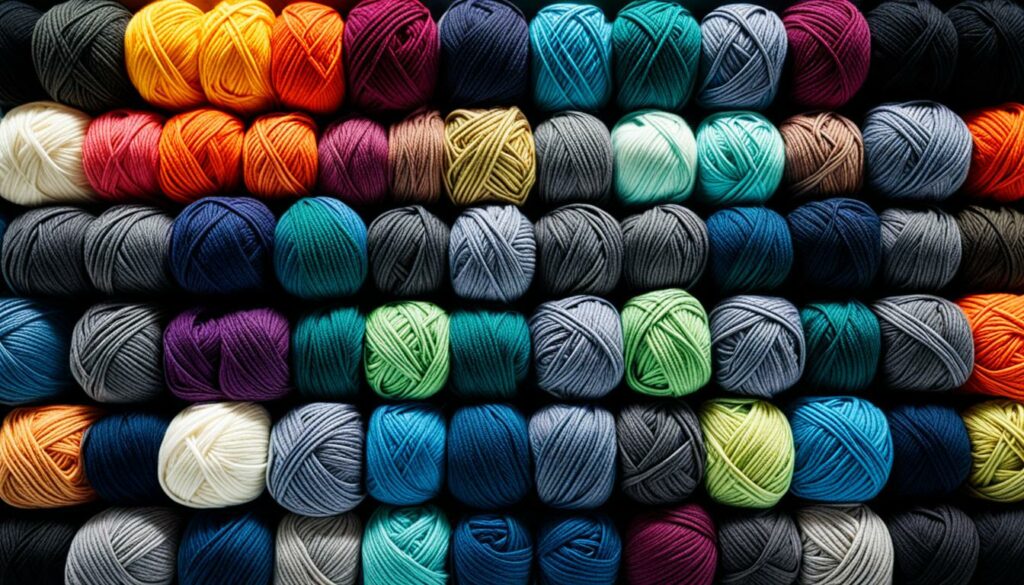
The Quality and Type of Yarn Materials
When it comes to yarn, the quality and type of materials used in its production play a vital role in determining its price. Yarn made from natural fibers like merino wool or cashmere is known for its superior quality and performance, making it a sought-after choice among knitting enthusiasts. These luxury yarns offer unparalleled softness, warmth, and durability, but their premium characteristics come at a higher cost.
In addition to natural fibers, there are also yarns crafted from synthetic fibers. These fibers can mimic the properties of natural materials while offering different benefits, such as increased affordability and washability. Synthetic yarns are often more budget-friendly compared to luxury yarns, making them a popular choice for everyday knitting projects.
Another factor that affects the cost of yarn is the inclusion of yarn blends. Yarn blends are created by combining different fibers, such as natural and synthetic materials, to achieve specific qualities and characteristics. These blends offer a balance of affordability and performance, catering to a wide range of knitting needs.
| Yarn Type | Characteristics | Price Range |
|---|---|---|
| Natural Fibers (e.g., Merino Wool, Cashmere) | Superior softness, warmth, and durability | Higher-end |
| Synthetic Fibers (e.g., Acrylic, Nylon) | Affordable, washable, and versatile | Mid-range |
| Yarn Blends (e.g., Wool/Acrylic Blend) | Combines the qualities of different fibers | Varies based on composition |
“Yarn made from the finest cashmere fibers offers unparalleled softness and luxury, perfect for creating heirloom-quality knitted pieces.”
Additionally, certain specialty yarns, such as hand-dyed or small-batch yarns, are known for their uniqueness and craftsmanship. These yarns are often created by independent artisans who take pride in their work, hand-dyeing yarn in small quantities to produce one-of-a-kind colorways. The artistry and attention to detail in these specialty yarns contribute to their higher price point, but they offer knitters an opportunity to create truly extraordinary projects.
The quality and type of yarn materials influence not only the price but also the overall knitting experience. Depending on your project requirements and budget, you can choose from a wide range of yarn options, from luxurious natural fibers to affordable synthetic blends.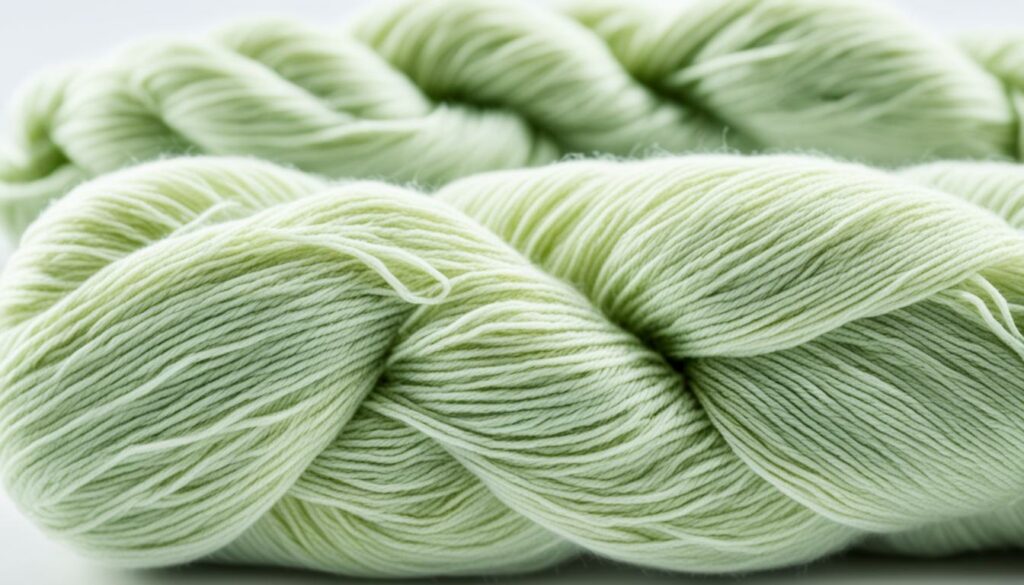
The Influence of Yarn Weight and Thickness
When it comes to yarn, weight and thickness are important factors that can affect its pricing. Yarns are available in various thicknesses, from bulky to fine, each serving different purposes and catering to unique knitting projects. The weight and thickness of yarn impact the amount of material required for production, which in turn influences the price.
Chunky or bulky yarns, such as those used for cozy sweaters or blankets, typically require more material to produce compared to finer yarns. As a result, these thicker yarns may be priced slightly higher due to the increased cost of raw materials and production. This allows manufacturers to account for the additional resources used in creating these bulkier yarns. Despite the higher price, many knitters appreciate the warmth and softness that chunky yarns offer, making them well worth the investment for certain projects.
On the other hand, fine yarns, which are often used for delicate items like lace shawls or lightweight garments, tend to be more affordable. The thinner threads used in finer yarns require less material, reducing the overall cost of production. This makes them a budget-friendly option for projects that require a lighter and more delicate touch.
The Versatility of Worsted Weight Yarn
One popular type of yarn is worsted weight yarn. Worsted weight refers to the medium thickness of the yarn, making it suitable for a wide range of projects. Due to its versatility and popularity, worsted weight yarn can be found at various price points, offering options for knitters with different budgets. Whether you’re creating a cozy sweater or a simple hat, worsted weight yarn provides the ideal balance between thickness and affordability.
The Specialized Appeal of Sock Yarn
Sock yarn is another type of yarn that varies in price due to its unique characteristics and purpose. Sock yarn is specifically designed to create durable and comfortable socks, often incorporating materials like nylon or elastic for added strength and stretch. Due to its specialized nature, sock yarn may be priced slightly higher compared to other types of yarn. The value lies in its durability and ability to withstand constant wear and tear, making it a worthwhile investment for those who love knitting socks.
Overall, the weight and thickness of yarn contribute to its pricing, with bulky yarns usually commanding a higher price and fine yarns offering a more affordable option. Specialized types of yarn, like worsted weight yarn and sock yarn, may also vary in price due to their suitability for particular projects. By understanding the influence of yarn weight and thickness on pricing, knitters can make informed decisions when selecting yarn for their creations.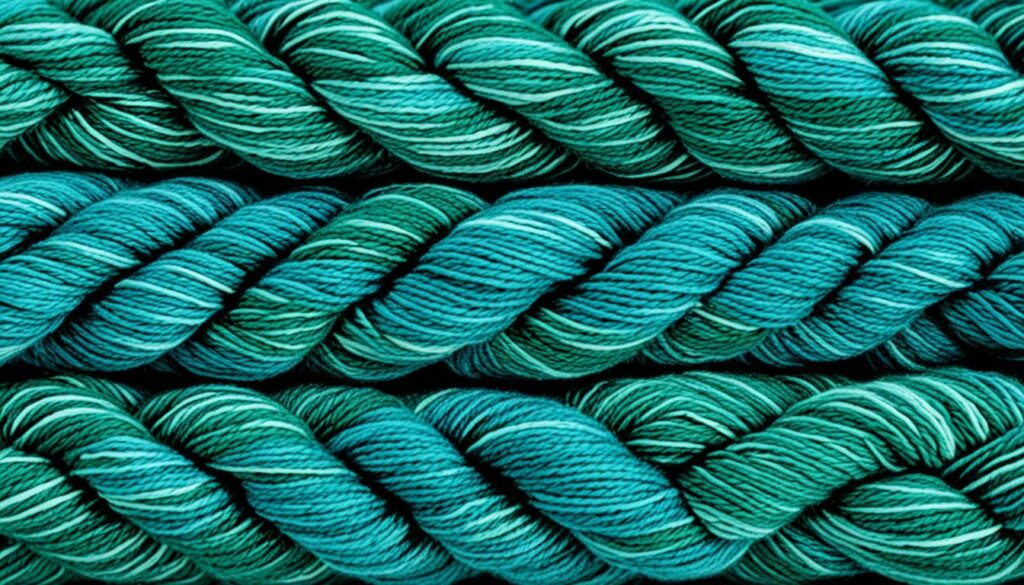
The Overhead Costs of Yarn Shops
When it comes to the cost of yarn, there are various factors at play. One significant aspect is the overhead costs associated with running a yarn shop. These expenses include rent, utilities, employee wages, and other operational costs that are factored into the pricing of yarn.
Running a physical retail store comes with its own set of financial responsibilities. Yarn shops need a physical space to display and store their products, which incurs rental expenses. Additionally, utilities such as electricity, water, and heating/cooling systems contribute to the overall overhead costs.
Employee wages are another aspect of retail overhead costs. Yarn shops typically employ knowledgeable and helpful staff to assist customers with their yarn purchases, provide guidance on projects, and offer knitting advice. Ensuring they have a dedicated and well-trained team requires investment in employee wages.
Furthermore, yarn shops often curate a selection of unique or premium yarns, catering to customers looking for something special or exclusive. These yarns may come with a higher price tag due to their quality, rarity, or craftsmanship, contributing to the retail markup.
So, while it may seem like yarn prices are solely determined by the cost of production and raw materials, it’s important to consider the additional expenses that yarn shops face in order to provide a physical retail experience to customers.
“Running a physical yarn shop involves various overhead costs such as rent, utilities, and employee wages, which are factored into the pricing of yarn.”
Comparing Overhead Costs of Yarn Shops
| Expense | Yarn Shop A | Yarn Shop B | Yarn Shop C |
|---|---|---|---|
| Rent | $2,500/month | $1,800/month | $3,000/month |
| Utilities | $400/month | $350/month | $500/month |
| Employee Wages | $3,000/month | $2,500/month | $3,500/month |
| Total Overhead Costs | $5,900/month | $4,650/month | $7,000/month |
As seen in the table above, different yarn shops may have varying overhead costs depending on factors such as location, size, and the number of staff members. These costs ultimately impact the pricing of the yarn sold in each store.
Understanding the overhead costs of yarn shops gives knitters and consumers insight into why yarn prices may differ between stores. By considering these factors, you can make more informed decisions when selecting yarn and managing your budget for knitting projects.
The Rise of Recycled Yarn and Sustainable Practices
In recent years, there has been a growing movement towards repurposing and recycling yarn. More and more knitters are embracing the idea of giving old garments new life by unraveling them and transforming them into beautiful recycled yarn. This sustainable practice not only reduces textile waste but also offers an affordable alternative to purchasing new yarn.
By repurposing old garments, you can obtain recycled yarn that carries a unique story and history. The process of unraveling sweaters and other knitted items allows you to salvage the yarn and give it a second chance. This not only adds a special charm to your knitting projects but also contributes to a more sustainable approach in the yarn industry.
“Recycled yarn is more than just a creative solution to repurposing old garments. It represents a commitment to reducing our environmental impact and promoting sustainability in the yarn industry.”
Repurposing old garments into recycled yarn also helps to address the issue of textile waste. By opting for recycled yarn, you are actively participating in reducing the amount of fabric that ends up in landfills. This small action plays a part in promoting a more sustainable and circular fashion system, where materials are reused and repurposed rather than discarded.
Initiatives like the Unraveling Club have emerged to educate and inspire knitters to embrace recycled materials. This community-driven movement provides resources and support to individuals interested in repurposing old garments to create their own unique yarn. Through the Unraveling Club, knitters can share tips, patterns, and stories of their recycled yarn projects, fostering a sense of camaraderie and a shared commitment to sustainability.
Advantages of Recycled Yarn:
- Reduces textile waste and landfill accumulation
- Offers an affordable and sustainable alternative to purchasing new yarn
- Provides a unique and storied yarn for your projects
- Promotes a circular fashion system that values repurposing and reusing materials
- Contributes to a more environmentally friendly and socially responsible yarn industry
As the demand for sustainable practices continues to grow, recycled yarn is emerging as a viable solution for knitters and the yarn industry as a whole. By repurposing old garments and embracing recycled yarn, you can actively contribute to reducing textile waste while enjoying the creative process and unique qualities that recycled yarn brings to your knitting projects.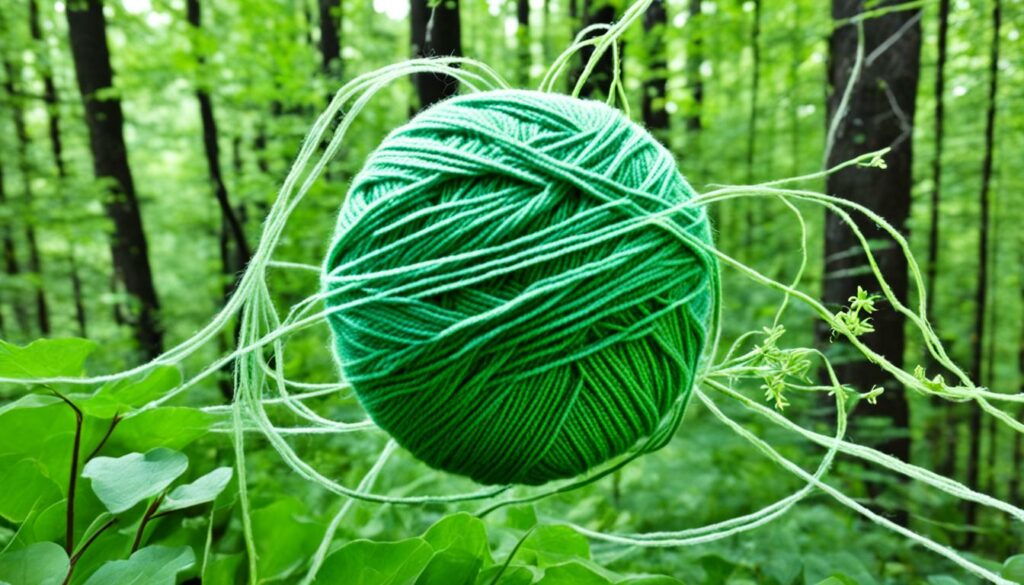
The Value of Hand-Dyed and Specialty Yarns
When it comes to yarn, there is an undeniable allure to hand-dyed and specialty varieties. These unique yarns not only captivate with their vibrant colors and exquisite textures but also carry a higher price tag. Crafted with meticulous care and attention to detail, hand-dyed and specialty yarns offer an unparalleled level of artistry that cannot be replicated.
Each skein tells a story, showcasing the skill and expertise of the artisan behind its creation. The process of hand-dyeing yarn involves carefully applying dyes by hand, resulting in breathtaking colorways that blend and meld in harmonious combinations. This level of artistry brings a sense of awe and wonder, elevating the knitting experience and transforming simple projects into works of art.
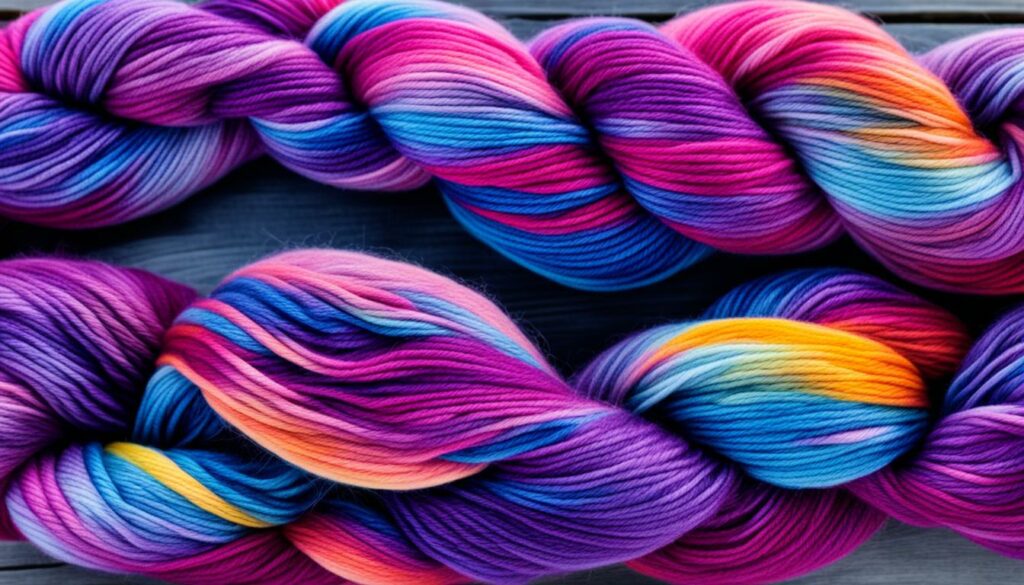
Specialty yarns, on the other hand, go beyond traditional fiber choices and design elements. They encompass a wide range of characteristics, such as luxurious fibers like silk, alpaca, or cashmere, as well as innovative blending techniques that result in unique textures and finishes. These yarns open up a world of possibilities for knitters, offering a chance to create garments and accessories with unparalleled beauty and style.
By investing in hand-dyed and specialty yarns, you not only gain access to a wide array of colors and material options but also support the continued growth and artistry in the yarn industry. These yarns are often produced in small batches, ensuring exclusivity and rarity. Knitting with such yarns enables you to bring your vision to life with a level of sophistication and elegance that sets your projects apart.
The Desirability of Hand-Dyed and Specialty Yarns
Nothing compares to the satisfaction and joy of working with hand-dyed and specialty yarns. The depth of color, the softness of the fibers, and the overall uniqueness of each skein make these yarns irresistible to knitters of all skill levels. They truly evoke a sense of awe and artistry in every stitch.
When you knit with hand-dyed and specialty yarns, you not only create beautiful garments and accessories but also become part of a vibrant and passionate community. These yarns inspire conversations, spark creativity, and foster connections with fellow knitters who share a love for the artistry of yarn production.
Choosing Hand-Dyed and Specialty Yarns
When selecting hand-dyed and specialty yarns, consider the project you have in mind and the effect you want to achieve. Whether you’re creating a statement piece or adding subtle pops of color to your design, these yarns offer a range of options to suit your needs.
Additionally, explore the various bases and materials available. From sumptuously soft merino wool to luxurious blends, each fiber brings its own unique qualities to the finished project. Don’t be afraid to experiment and step outside your comfort zone; that’s where the magic happens.
The Investment in Artistry
Hand-dyed and specialty yarns are more than just materials for knitting—they are investments in the artistry and passion of yarn production. These yarns allow you to create one-of-a-kind pieces that reflect your individuality and style. They turn every project into a canvas, where color and texture blend seamlessly to bring your vision to life.
| Yarn | Description |
|---|---|
| Artisanal Hand-Dyed Yarn | Meticulously hand-dyed by skilled artisans, these yarns feature stunning color combinations and gradients that elevate your projects to new heights. |
| Specialty Blends | Explore the world of luxury fibers and blending techniques with specialty yarns. Cashmere, silk, and alpaca are just a few of the materials that add an extra touch of sophistication to your knitting. |
| Unique Textures | Step into a realm of creativity with yarns that boast unique textures and finishes. From fluffy boucle to smooth and silky, these yarns lend a distinctive touch to your projects. |
Indulging in hand-dyed and specialty yarns is not only a treat for your knitting needles but also a celebration of the passion, skill, and artistry that goes into yarn production. With every stitch, you can appreciate the beauty and uniqueness of these yarns, making each project a masterpiece.
Finding the Balance: Quality and Budget
When it comes to choosing yarn, one of the key considerations is finding the right balance between quality and budget. While there are luxurious yarn options made from premium fibers that can be quite expensive, there are also affordable alternatives that offer good quality for those on a tight budget.
As a knitter or consumer, it is important to assess your project requirements and budget before making a yarn purchase. By considering your specific needs and limitations, you can make a well-informed decision that satisfies both your desire for high-quality yarn and your financial constraints.
Whether you’re working on a large-scale project or a small, intricate design, there are budget-friendly yarn options available that still deliver satisfactory results. Many reputable yarn brands offer cost-effective choices that maintain a good balance between price and quality.
One option for affordable yarn is to explore blends of natural and synthetic fibers. These blends often provide the desired characteristics of higher-end natural fibers at a more accessible price point. They can be a cost-effective alternative that doesn’t compromise on quality.
Another consideration is to look for sales, discounts, or promotions offered by yarn retailers. Often, you can find high-quality yarns at reduced prices during seasonal sales or clearances. These opportunities allow you to shop for the yarn you love without breaking the bank.
A practical strategy for balancing quality and budget is to start with small, less expensive projects. By doing so, you can experiment with different yarns, gain experience, and discover which options work best for you. This approach allows you to gradually invest in pricier yarns as you gain confidence and take on more complex projects.
“Choosing yarn involves finding the right balance between quality and budget.” – Knitting Enthusiast
Quality Tips for Budget-Friendly Yarn:
- Consider yarns with machine washable properties to reduce long-term maintenance costs.
- Look for budget-friendly options in local yarn shops or online marketplaces that offer a wide variety of choices.
- Explore yarns with adequate yardage or meterage, maximizing the value you get for each skein or ball.
- Read reviews and seek recommendations from fellow knitters or community groups to identify affordable yarn options without compromising on quality.
- Keep an eye out for clearance sales or end-of-season discounts to find high-quality yarns at a fraction of their original price.
Remember, finding the perfect yarn for your projects is all about striking the right balance between quality and budget. With a little research, creativity, and awareness of affordable options, you can knit beautiful creations while staying within your financial means.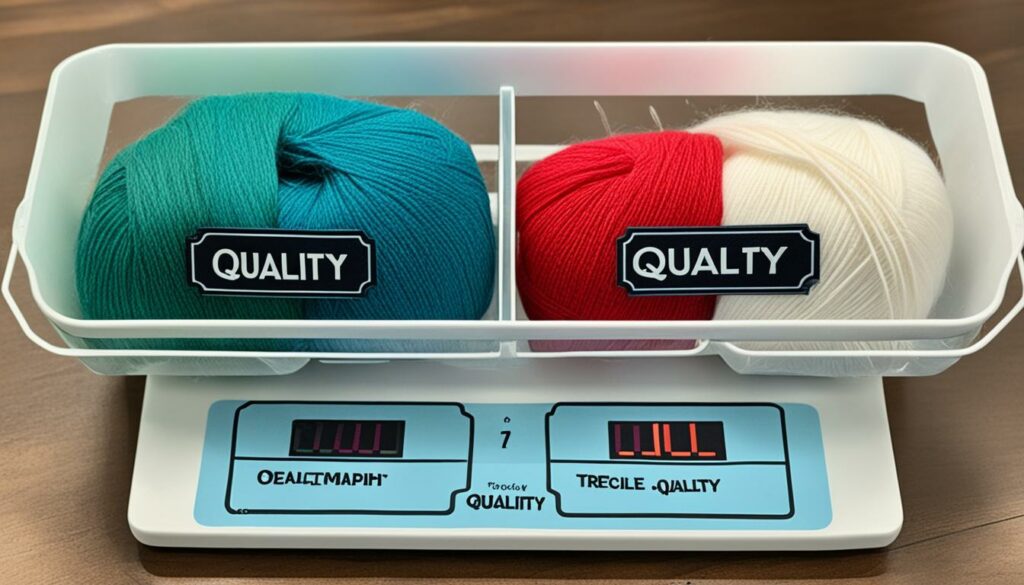
The Future of Sustainable Yarn and Innovative Technologies
The yarn industry is undergoing a transformation to meet the growing demand for sustainability and environmentally friendly practices. Innovations in yarn production methods and materials are revolutionizing the way yarn is made, paving the way for a more sustainable future.
One of the key developments in sustainable yarn production is the rise of recycled yarn. By repurposing old garments and textile waste, yarn manufacturers are reducing the environmental impact of the industry. Recycled yarn not only helps to minimize textile waste but also offers a more cost-effective and eco-friendly alternative for knitters.

Furthermore, sustainable materials are being used in the production of yarn. Natural fibers like organic cotton, bamboo, and hemp are gaining popularity due to their renewable and environmentally friendly characteristics. These materials require fewer resources, such as water and fertilizers, making them a more sustainable choice for yarn production.
“The yarn industry is embracing sustainable practices to reduce its ecological footprint and create a more responsible supply chain.” – Eco Yarn Co.
In addition to sustainable materials, innovative technologies are playing a vital role in shaping the future of the yarn industry. Automatic knitting machines, for example, offer increased efficiency and reduced waste by precisely controlling yarn consumption. These machines can produce yarn and clothing in a more sustainable and cost-effective manner, benefiting both manufacturers and consumers.
The Benefits of Sustainable Yarn and Innovative Technologies
The adoption of sustainable yarn and innovative technologies brings several benefits to both the industry and consumers. By prioritizing sustainability, the yarn industry can significantly reduce its carbon footprint and contribute to the preservation of natural resources.
- Environmentally friendly yarn production methods help minimize textile waste and reduce the need for virgin materials.
- Sustainable materials offer a renewable alternative to traditional fibers, promoting biodiversity and reducing the use of harmful chemicals.
- Innovative technologies enhance efficiency and reduce waste, leading to cost savings for manufacturers and potentially lower prices for consumers.
- Socially responsible practices foster transparency and accountability within the yarn industry, ensuring fair labor conditions and promoting ethical sourcing.
Embracing sustainability and leveraging innovative technologies in the yarn industry is crucial to meet the evolving demands of environmentally conscious consumers. By making socially responsible choices, yarn manufacturers and consumers can contribute to a greener and more sustainable future.
Conclusion
Understanding the various factors that contribute to the cost of yarn is crucial for making informed choices. Yarn prices are influenced by inflation, supply and demand, the quality of materials, and production methods. By considering these factors, you can navigate the yarn market and find options that align with your budget and project requirements.
Moreover, exploring sustainable yarn practices is not only beneficial for the environment but also supports a socially responsible yarn industry. Embracing recycled yarn and opting for sustainable materials can help reduce textile waste and promote a more sustainable future for the industry. As a knitter or consumer, you have the power to contribute to these positive changes.
So, the next time you embark on a knitting project, remember to consider the yarn pricing factors and explore sustainable options. By doing so, you can enjoy your craft while also supporting a more environmentally friendly and socially responsible yarn industry. Let’s knit with a purpose and make a positive impact.
FAQ
Why does yarn cost so much?
How does inflation impact yarn prices?
What role does supply and demand play in yarn pricing?
How does the quality and type of yarn materials affect pricing?
Does the weight and thickness of yarn affect its pricing?
How do overhead costs of yarn shops impact yarn pricing?
What is the significance of recycled yarn and sustainable practices in the yarn industry?
Why are hand-dyed and specialty yarns more expensive?
How can I find the right balance between quality and budget when choosing yarn?
What does the future hold for sustainable yarn and innovative technologies in the industry?
Why is it important to understand the factors that contribute to the cost of yarn?
Vivienne – Your Content Companion Vivienne is your content companion, curating valuable tips, advice, and inspiration to guide you on your home decor journey. From insightful blog posts to informative product descriptions, she’s here to empower you with the knowledge you need to create your dream space.
Yarn
Is Yarn Natural or Manmade? Unravel the Truth
Discover if yarn is natural or manmade, explore diverse yarn materials and understand their unique characteristics for your next project.

When you think of yarn, do you picture a cozy sweater made from natural fibers or a vibrant scarf crafted from synthetic materials? Yarn comes in a variety of types, but what exactly distinguishes natural fiber yarn from its manmade counterparts? Is one better than the other? Let’s dive into the world of yarn and uncover the truth about its origins, characteristics, and best uses.
Key Takeaways:
- Yarn can be categorized as either natural fiber yarn or synthetic fiber yarn.
- Natural fiber yarn is made from materials that occur in nature, such as cotton, wool, silk, and linen.
- Synthetic fiber yarn is created through chemical processes using materials like acrylic, polyester, and nylon.
- Natural fiber yarn offers breathability, comfort, and a natural aesthetic, while synthetic fiber yarn provides affordability, durability, and versatility.
- Understanding the characteristics and properties of different yarn types can help you make informed crafting decisions.
Understanding Natural Fiber Yarn
Natural fiber yarn is highly regarded for its breathability, durability, and suitability for sensitive skin. The use of natural materials lends these yarns a unique set of characteristics that make them a popular choice among crafters. Let’s explore the different kinds of natural fiber yarn and delve into their production process and distinctive qualities.
Cotton Yarn
Cotton yarn is sought after for its softness, lightweight nature, and exceptional absorbency. It is ideal for warm-weather projects, as it allows for excellent breathability and moisture management. Cotton yarn is derived from the cotton plant, and the fibers are extracted through a series of processes, including shearing, carding, spinning, and dyeing. This yarn holds its shape well and is suitable for a variety of knitting and crocheting projects.
Wool Yarn
Wool yarn is known for its warmth, elasticity, and remarkable moisture-wicking properties. It is an excellent choice for colder climates, as it provides insulation without feeling heavy. Wool yarn is sourced from sheep and other animals, and its production involves similar processes as cotton yarn, such as shearing, carding, spinning, and dyeing. The unique structure of wool fibers allows them to trap air, providing excellent heat retention. Additionally, wool has the ability to regulate body temperature, making it a versatile choice for various projects.
Other Natural Fiber Yarns
In addition to cotton and wool, there are other natural fibers used in yarn production, such as silk and linen. Silk yarn is derived from silk worms and is known for its luxurious feel and lustrous appearance. Linen yarn, made from flax fibers, offers strength, durability, and a crisp texture. Each type of natural fiber yarn has its own set of characteristics, allowing crafters to explore a wide range of options for their projects.
“Natural fiber yarns, such as cotton and wool, possess unique qualities that can enhance your knitting or crocheting projects. From the softness of cotton to the warmth of wool, these yarns offer a delightful crafting experience.”
| Fiber Type | Characteristics |
|---|---|
| Cotton | Soft, lightweight, absorbent |
| Wool | Warm, elastic, moisture-wicking |
| Silk | Luxurious, lustrous |
| Linen | Strong, durable, crisp |
Exploring Synthetic Fiber Yarn
When it comes to choosing yarn for your projects, synthetic fiber yarn offers a wide range of advantages. One of the key benefits is its affordability, making it an excellent choice for budget-conscious crafters. In addition, synthetic fiber yarn is known for its versatility, as it can easily mimic the characteristics of various natural fibers such as cotton or wool. Whether you’re looking for softness, durability, or resistance to stretching, there’s a synthetic fiber yarn that fits your needs.
What sets synthetic fiber yarn apart is its engineered nature. Through a process known as yarn production, synthetic fibers are chemically created to exhibit specific characteristics. For example, acrylic yarn is known for its softness and lightweight feel, while polyester yarn offers excellent durability and resistance to wrinkles and stretching. This enables crafters to achieve consistent and reliable results in their projects.
The production of synthetic fiber yarn involves careful chemical processes like polymerization and extrusion. As a result, synthetic fibers are created with consistent properties, from the colorfastness to the strength and resistance to shrinkage. This ensures that synthetic fiber yarn can withstand the wear and tear of frequent use and maintain its shape and integrity over time.
When considering synthetic fiber yarn, it’s important to weigh the characteristics and advantages it offers. Take a look at the table below for a comparison of different synthetic fiber yarn types:
| Yarn Type | Characteristics |
|---|---|
| Acrylic Yarn | Soft, lightweight, and affordable |
| Polyester Yarn | Durable, resistant to stretching, and colorfast |
| Nylon Yarn | Strong, lightweight, and quick-drying |
As you can see, each type of synthetic fiber yarn has its own unique qualities that cater to different project requirements. Whether you’re creating cozy sweaters, durable blankets, or vibrant accessories, synthetic fiber yarn offers a multitude of options to bring your creative vision to life.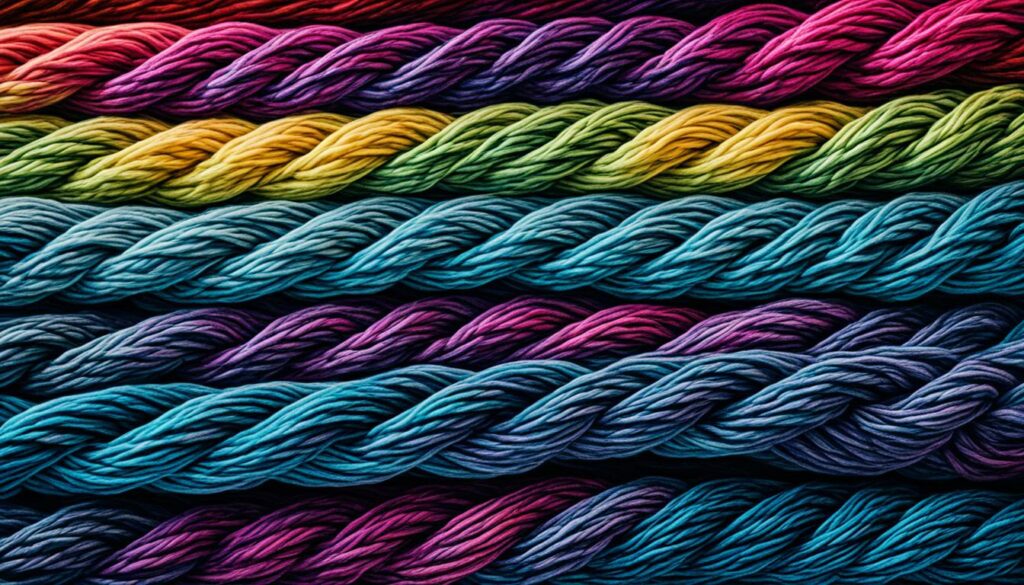
Infographic: Synthetic Fiber Yarn Characteristics
For a quick reference, here’s an infographic highlighting the characteristics of synthetic fiber yarn: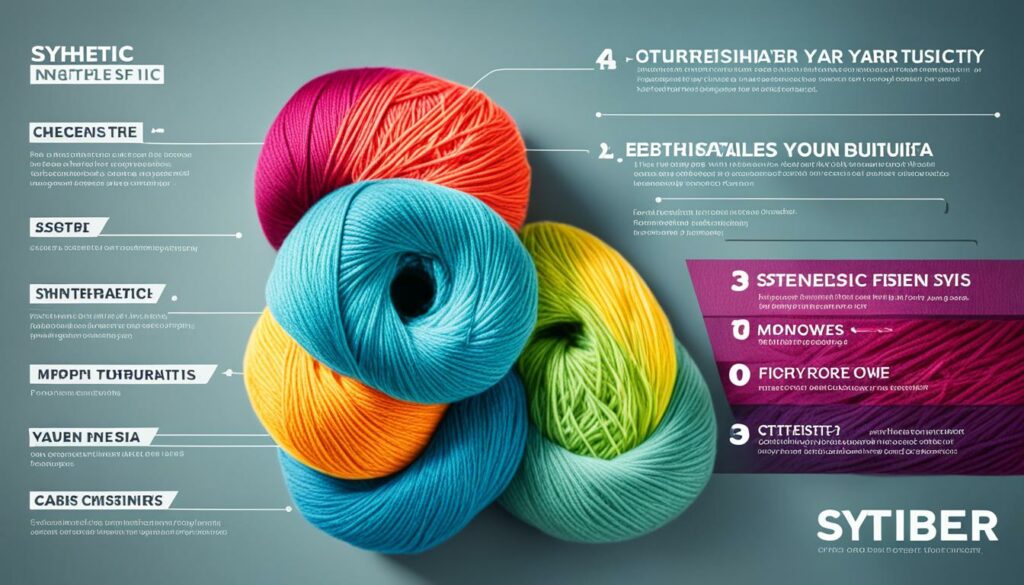
With synthetic fiber yarn’s affordability, versatility, and durability, it’s no wonder that it has become a popular choice among crafters. Whether you’re a beginner or an experienced yarn enthusiast, synthetic fiber yarn offers a world of creative possibilities.
Identifying Natural and Manmade Yarn
When choosing yarn for your next project, it’s important to be able to distinguish between natural and manmade yarn. One simple method for identifying the type of yarn is through a burn test. Natural fiber yarn, such as cotton or wool, will behave differently when burned compared to synthetic fiber yarn, like acrylic or polyester.
During a burn test, natural fibers will burn slowly and curl away from the flame. They may also leave behind a lingering smell similar to burning hair. On the other hand, synthetic fibers tend to burn more quickly and may melt or shrink. You may notice a distinct odor similar to burning plastic.
Characteristics of Natural and Synthetic Yarn
Natural fiber yarns have distinct characteristics that differentiate them from synthetic yarns. They often have a specific feel and appearance, with subtle variations in texture and sheen. Natural fiber yarns, like cotton and wool, may have slight imperfections and irregularities that add to their charm.
Synthetic fiber yarns, on the other hand, tend to have a more uniform texture and sheen. They are often created through chemical processes, resulting in fibers with consistent properties. Synthetic yarns can offer a wide range of colors and textures, making them ideal for projects that require specific aesthetics.
In a burn test, natural fiber yarn will burn slowly and curl away from the flame, while synthetic fiber yarn will burn more quickly and may shrink or melt. Natural fiber yarns have a unique feel and appearance, while synthetic fiber yarns often have a more uniform texture and sheen.
The production process for natural and synthetic yarn also differs. Natural fiber yarn is typically made from plant or animal materials that undergo processes like shearing, carding, spinning, and dyeing. These processes preserve the inherent qualities of the fibers and result in yarn with unique properties.
On the other hand, synthetic fiber yarn is produced through chemical processes like polymerization and extrusion. These processes allow for the creation of fibers with desired characteristics, such as strength, colorfastness, and resistance to wrinkles and shrinkage.
Comparison of Natural and Synthetic Yarn
| Natural Yarn | Synthetic Yarn |
|---|---|
| Derived from plant or animal materials | Created through chemical processes |
| Unique feel and appearance | Uniform texture and sheen |
| Subject to natural variations and imperfections | Consistent properties and colors |
| Generally biodegradable and renewable | Not biodegradable and made from non-renewable resources |

Understanding the differences between natural and synthetic yarn can help you make informed decisions when selecting yarn for your projects. Whether you prefer the unique qualities of natural fiber yarn or the versatility of synthetic fiber yarn, each type has its own set of characteristics and benefits. Consider your project requirements and personal preferences to find the perfect yarn for your next knitting or crocheting adventure.
The Benefits of Natural Fiber Yarn
Natural fiber yarn offers several benefits that make it a popular choice for crafters and fashion enthusiasts alike. Whether you’re knitting a cozy sweater or creating intricate crochet designs, here are some reasons why natural fiber yarn should be on your radar.
Biodegradable and Sustainable
Natural fiber yarn is biodegradable, meaning it can decompose over time without leaving behind harmful waste. Unlike synthetic fibers that contribute to plastic pollution, natural fiber yarns provide an eco-friendly alternative. By choosing natural fiber yarn, you’re making a sustainable choice and reducing your environmental impact.
Breathable and Comfortable
One of the standout characteristics of natural fiber yarn is its breathability. Yarns made from cotton, wool, silk, and other natural materials allow air to circulate, helping to regulate body temperature and keeping you comfortable in any season. The breathability of natural fiber yarns also makes them ideal for projects like lightweight summer garments.
Moisture-Wicking Properties
Natural fiber yarns have inherent moisture-wicking properties, meaning they can absorb moisture and draw it away from the skin. This feature makes natural fiber yarn perfect for creating cozy activewear, socks, or other items that come into contact with sweat. With natural fiber yarn, you can stay dry and comfortable during physical activities.
Unique Texture and Aesthetic
Each natural fiber presents its own unique texture and aesthetic appeal. Cotton yarn offers a soft and smooth feel, while wool yarn provides warmth, elasticity, and a cozy touch. The rich and luxurious look of silk yarn adds elegance to any project, while linen yarn offers a rustic and textured appearance. These distinct characteristics allow you to experiment with different yarns to achieve desired textures and appearances in your creations.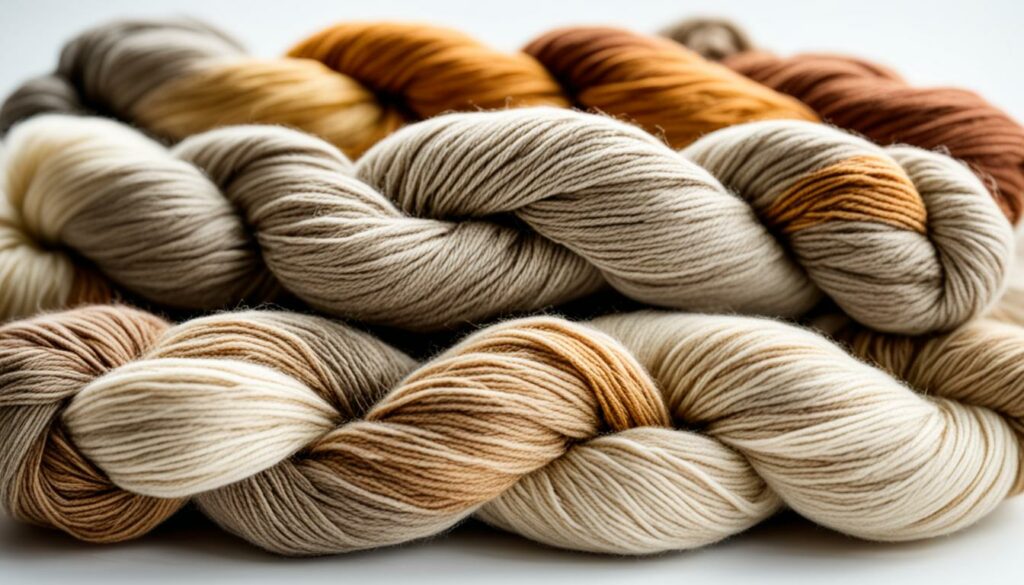
As you can see, natural fiber yarn brings numerous benefits to your projects. Not only is it sustainable and comfortable, but it also offers a wide range of unique textures and aesthetics. By incorporating natural fiber yarn into your knitting and crocheting, you can create beautiful, eco-friendly pieces that are as enjoyable to make as they are to wear.
The Advantages of Synthetic Fiber Yarn
Synthetic fiber yarn offers several advantages that make it a popular choice for various projects. Whether you’re a knitting enthusiast or a crochet lover, synthetic fiber yarn can be a versatile and practical option. Here are some key benefits of using synthetic fiber yarn:
- Affordability: Synthetic fiber yarn is often more budget-friendly compared to natural fiber yarn. This makes it a great choice for crafters who want to create beautiful projects without breaking the bank.
- Wide range of colors and textures: Synthetic fiber yarn is available in an extensive array of vibrant colors and textures. Whether you prefer a bold and eye-catching design or a subtle and soft texture, there’s a synthetic fiber yarn that suits your creative vision.
- Low maintenance: One of the advantages of synthetic fiber yarn is its resistance to wrinkles, shrinking, and fading. This makes it highly suitable for projects that require minimal care and can withstand regular use and washing.
- Allergy-friendly: For individuals with allergies to natural fibers like wool or silk, synthetic fiber yarn can be a great alternative. It doesn’t trigger common allergies and provides a comfortable crafting experience without any discomfort or irritation.
If you’re looking for an affordable, vibrant, and low-maintenance yarn option, synthetic fiber yarn is an excellent choice. Its wide range of colors and textures, coupled with its allergy-friendly nature, make it a go-to choice for many crafters. Experimenting with synthetic fiber yarn can add a unique touch to your projects and help you achieve stunning results.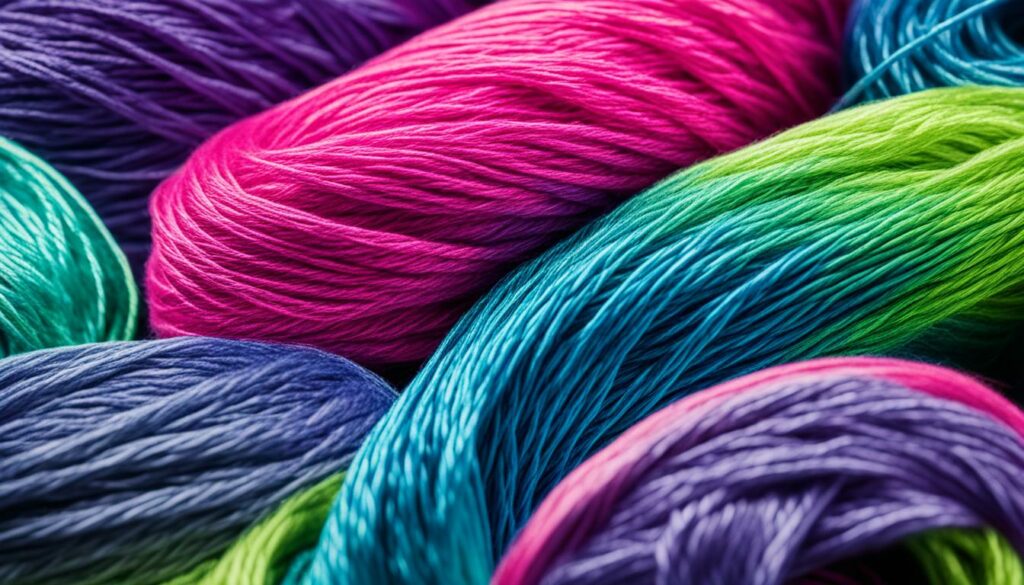
Choosing the Right Yarn for Your Project
When it comes to selecting yarn for your project, it’s important to consider the specific characteristics required for the item you are creating. Both natural fiber yarn and synthetic fiber yarn have unique qualities that make them suitable for different types of projects.
Natural fiber yarn is an excellent choice for garments, accessories, and items that come into direct contact with the skin. It offers breathability, comfort, and a natural aesthetic. Natural fiber yarn is made from materials like cotton, wool, silk, and linen, which are derived from nature. These yarns have a soft feel and can provide warmth or maintain coolness, depending on the type of fiber used. They are also known for their absorbency and ability to regulate body temperature. Natural fiber yarn is produced through processes like shearing, carding, spinning, and dyeing, preserving the inherent qualities of the fibers.
“`html
Natural fiber yarn is suitable for:
- Garments
- Accessories
- Items in direct contact with the skin
“`
Synthetic fiber yarn, on the other hand, is often preferred for items that need to retain their shape and durability. If you’re making blankets or outdoor gear, synthetic fiber yarn is a great option. Synthetic fibers like acrylic, polyester, and nylon are engineered through chemical processes to have specific characteristics such as strength, colorfastness, and resistance to wrinkles and shrinkage. Acrylic yarn, for instance, is known for its softness and affordability, while polyester yarn is durable and resistant to stretching. Synthetic fiber yarn is produced through processes like polymerization and extrusion, resulting in fibers with consistent properties.
“`html
Synthetic fiber yarn is suitable for:
- Blankets
- Outdoor gear
- Items requiring shape retention and durability
“`
When choosing the right yarn for your project, don’t be afraid to experiment with different types. Each type of yarn offers its own unique set of qualities and benefits. By understanding the characteristics of both natural and synthetic fiber yarns, you can make informed decisions and create beautiful, functional items that suit your needs.
Next, let’s explore some tips for working with natural and synthetic yarn to ensure successful projects.
Tips for Working with Natural and Synthetic Yarn
Working with yarn can be a delightful and creative experience, whether you’re using natural fiber yarn or synthetic fiber yarn. Each type of yarn has its own unique characteristics and requires a slightly different approach. Here are some useful tips to help you make the most of your knitting or crocheting projects:
Working with Natural Fiber Yarn
When working with natural fiber yarn, it’s important to take into account its inherent qualities and properties. Here are some tips to keep in mind:
- Pay attention to blocking: Natural fiber yarn has memory, which means it can easily be shaped. This makes it important to block your finished projects to ensure that they maintain their desired shape. Blocking involves gently shaping your project by wetting or steaming it and allowing it to dry in the desired shape.
- Handle with care: Natural fiber yarn, such as cotton, wool, silk, or linen, can be more delicate compared to synthetic yarn. Take care when handling, as it can potentially shrink or felt if exposed to high temperatures or harsh agitation. Follow the washing instructions provided on the yarn label to ensure proper care.
- Consider fiber-specific techniques: Different natural fiber yarns may require specific techniques. For example, wool yarn benefits from gentle blocking with water, while linen yarn typically benefits from steam blocking.
Working with Synthetic Fiber Yarn
Synthetic fiber yarns, such as those made from acrylic, polyester, or nylon, offer their own set of advantages. Here are some tips to keep in mind when working with synthetic fiber yarn:
- Be mindful of blocking: Synthetic fiber yarn is generally less likely to shrink compared to natural fiber yarn. However, it may not hold blocking as well. Keep this in mind when shaping your projects and consider alternative blocking methods.
- Be aware of static electricity: Synthetic fiber yarn can be more prone to static electricity, which can be noticeable when wearing or working with the yarn. Consider using anti-static sprays or fabric softeners to help reduce static.
- Experiment with different stitches: Synthetic fiber yarns often have a more uniform texture and can be forgiving when it comes to stitch mistakes. This makes it a great option for trying out new stitches or patterns.
Remember, regardless of the type of yarn you choose, experimenting with different techniques and learning from your experiences will help you become more comfortable and skilled in working with yarn. Don’t be afraid to try new things and let your creativity flow!
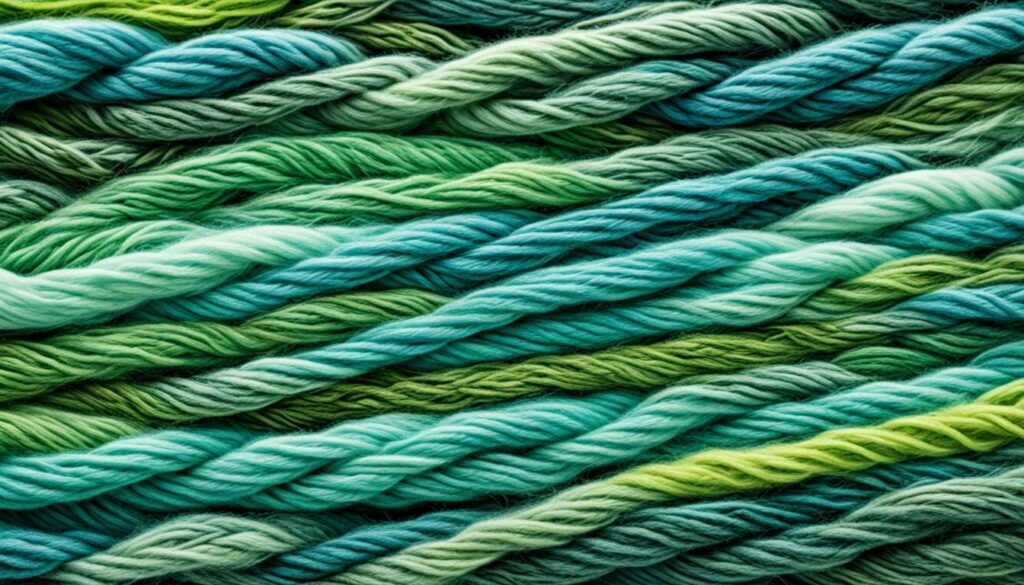
| Working with Natural Fiber Yarn | Working with Synthetic Fiber Yarn |
|---|---|
| Natural fiber yarn has memory and can easily be shaped. Pay attention to blocking and gently shape your projects to maintain their desired shape. | Synthetic fiber yarn is less likely to shrink, but it may not hold blocking as well. Be mindful of the blocking techniques you use. |
| Natural fiber yarn can shrink or felt if not handled properly. Follow the washing instructions on the yarn label to ensure proper care. | Synthetic fiber yarn can be more prone to static electricity. Use anti-static sprays or fabric softeners to reduce static. |
| Consider fiber-specific techniques for different natural fiber yarns. For example, wool benefits from gentle blocking with water, while linen yarn typically benefits from steam blocking. | Synthetic fiber yarn often has a more forgiving nature and can be great for experimenting with different stitches and patterns. |
Caring for Natural and Synthetic Yarn
Proper care and maintenance are essential for keeping your natural fiber yarn and synthetic fiber yarn in top condition. By following a few simple guidelines, you can ensure that your yarn retains its quality and lasts for years to come.
Caring for Natural Fiber Yarn
Natural fiber yarn, such as cotton, wool, silk, and linen, requires gentle washing and special attention. Here are some tips for caring for your natural fiber yarn:
- Washing: Hand wash natural fiber yarn using a mild detergent in cool water.
- Drying: After washing, reshape the garment or item made from natural fiber yarn and lay it flat to dry. This helps maintain the shape and prevent stretching.
- Storage: Store natural fiber yarn in a cool, dry place to prevent damage from moths or humidity. Avoid storing it in plastic bags, as these can trap moisture.
By following these care instructions, you can keep your natural fiber yarn looking and feeling its best.
Caring for Synthetic Fiber Yarn
Synthetic fiber yarn, such as acrylic, polyester, and nylon, is generally easier to care for and more durable. Here are some tips for caring for your synthetic fiber yarn:
- Washing: Synthetic fiber yarn can usually withstand machine washing. Follow the care instructions on the yarn label.
- Drying: Synthetic fiber yarn can be dried in a machine dryer, but it’s best to use low heat or air dry to prevent excessive pilling.
- Pilling: Over time, synthetic fiber yarn may develop small fiber balls called pills. You can remove pills using a fabric shaver or carefully snipping them off with sharp scissors.
With proper care, your synthetic fiber yarn will remain soft, vibrant, and resistant to wear and tear.
Remember, whether you’re working with natural fiber yarn or synthetic fiber yarn, it’s important to read the care instructions on the yarn label and consider any specific recommendations from the yarn manufacturer.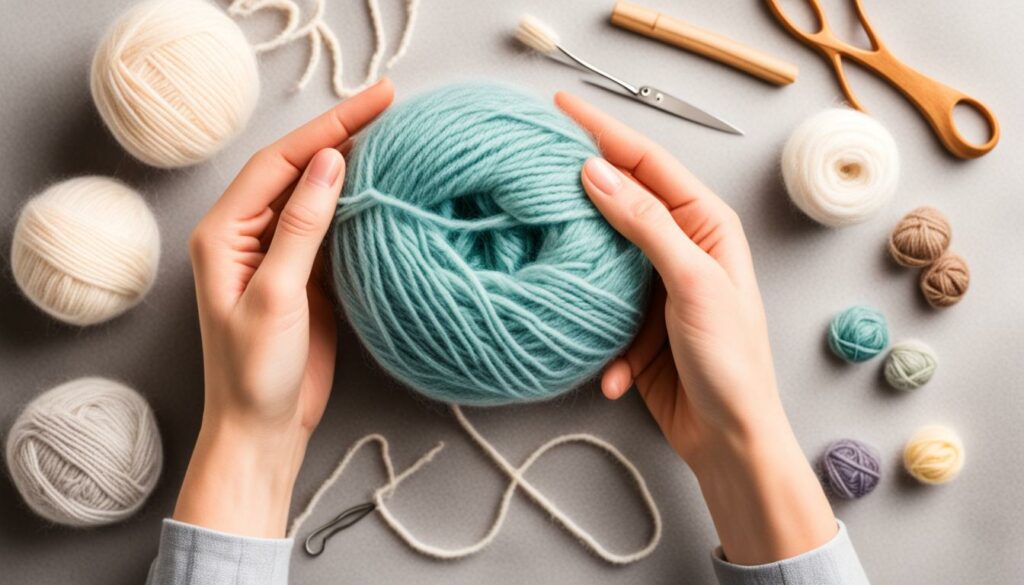
Following these care guidelines will help you keep your yarn in excellent condition, ensuring that you can enjoy your knitting or crocheting projects for years to come.
Exploring Yarn Sustainability
When it comes to sustainability, choosing the right yarn materials is crucial. Natural fiber yarn, such as cotton and wool, is often considered more eco-friendly due to its biodegradability and renewable sources. These yarns are derived from plants and animals, making them a sustainable choice for those concerned about the environment.
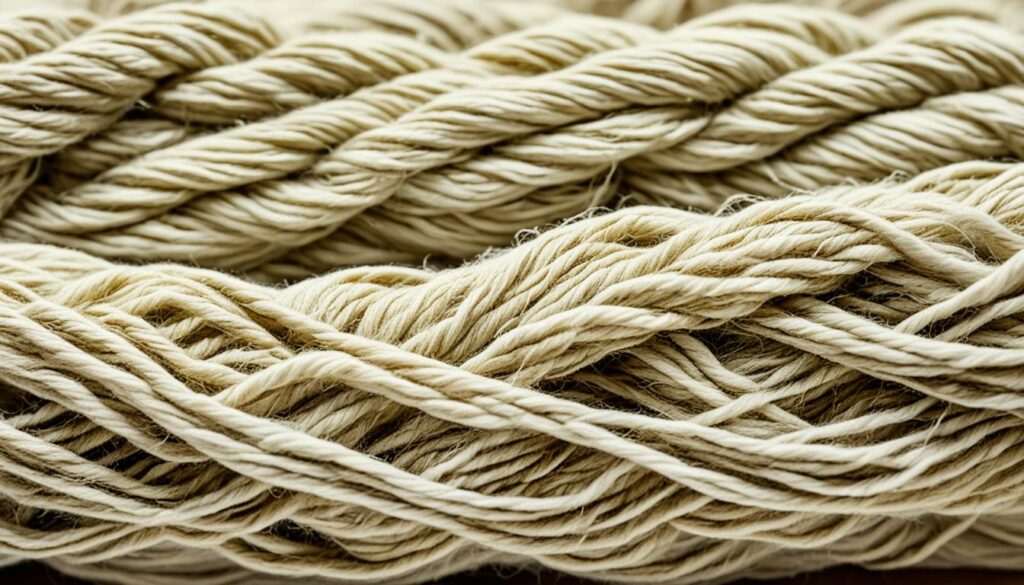
However, synthetic fiber yarn can also contribute to sustainability efforts. Many synthetic yarns are made from recycled materials, reducing waste and decreasing the demand for new resources. Additionally, advancements in manufacturing processes have enabled the production of synthetic fibers in a more sustainable manner.
When making sustainable choices, consider the environmental impact of the materials used in the production of yarn. Take into account factors such as the energy consumption, water usage, and chemical treatments involved in the manufacturing process. Look for certifications or labels that indicate environmentally friendly practices, such as organic or recycled materials.
Another consideration is the lifespan and recyclability of the yarn. Natural fiber yarns, although biodegradable, may have a shorter lifespan than synthetic fiber yarns. However, they can easily decompose and return to the earth, minimizing their impact on the environment. On the other hand, synthetic fiber yarns can be recycled and made into new products, extending their lifespan and reducing waste.
“The choices we make in our crafting projects can have a positive impact on the environment. By opting for sustainable yarn materials, we contribute to the conservation of natural resources and reduce our carbon footprint.”
| Yarn Type | Benefits | Considerations |
|---|---|---|
| Natural Fiber Yarn | – Biodegradable | – Shorter lifespan |
| Synthetic Fiber Yarn | – Made from recycled materials | – Long lifespan |
Ultimately, the choice between natural fiber yarn and synthetic fiber yarn depends on your project’s specific requirements and your own sustainability goals. By being mindful of the materials used in crafting, we can contribute to a greener future and enjoy our creative endeavors guilt-free.
The Future of Yarn Innovation
The yarn industry is constantly evolving, driven by advancements in technology and a growing focus on sustainability. Exciting developments in yarn production, materials, and types are shaping the future of this beloved craft. Let’s explore some of the innovative trends that are revolutionizing the world of yarn.
Recycled Yarns: Eco-Friendly and Stylish
Recycled yarns are gaining popularity as a sustainable alternative to traditional yarn materials. These yarns are made from post-consumer or post-industrial waste, such as plastic bottles or textile remnants, that are transformed into new fibers. By diverting waste from landfills, recycled yarns contribute to a circular economy and reduce the environmental impact of yarn production. Additionally, these eco-friendly yarns come in a variety of colors and textures, allowing crafters to create beautiful and unique projects.
Plant-Based Synthetics: Nature-Inspired Yarns
Plant-based synthetic yarns are another exciting innovation in the world of yarn. These yarns are derived from renewable sources such as bamboo, hemp, or corn. They offer the benefits of synthetic fiber yarns, such as durability and easy care, while also providing a more sustainable option. Plant-based synthetics can be blended with natural fibers or used on their own, offering versatile options for various projects. Crafters can enjoy the performance of synthetic yarns while minimizing their environmental footprint.
Biodegradable Fibers: Sustainable and Earth-Friendly
Biodegradable fibers are revolutionizing the yarn industry and addressing the issue of microplastic pollution. These fibers are designed to break down naturally over time, reducing their impact on the environment. Materials such as lyocell and hemp are known for their biodegradability, as they can be composted or decomposed without releasing harmful toxins. Crafters who prioritize sustainability can now choose biodegradable yarns to create beautiful projects while minimizing their ecological impact.
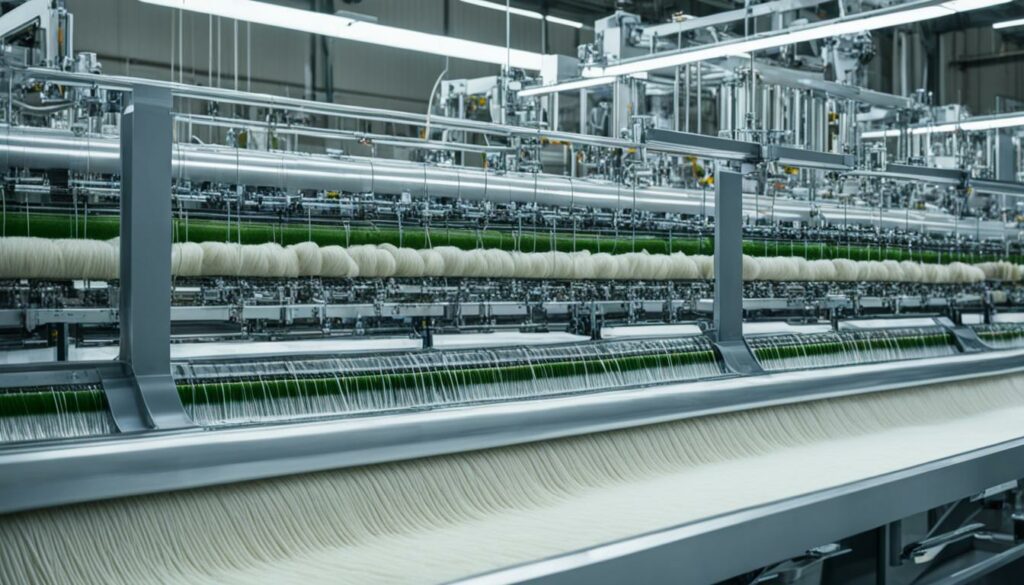
With these innovative advancements in yarn production, materials, and types, the future of yarn is brighter than ever. Crafters now have access to a wide range of sustainable and performance-driven options. Whether you prefer recycled yarns, plant-based synthetics, or biodegradable fibers, there are exciting choices for every project.
Comparison Table: Yarn Innovations at a Glance
| Yarn Innovation | Benefits |
|---|---|
| Recycled Yarns | – Sustainable – Wide range of colors and textures – Reduces waste |
| Plant-Based Synthetics | – Renewable – Durable and easy care – Nature-inspired fibers |
| Biodegradable Fibers | – Sustainable – Minimizes microplastic pollution – Compostable or decomposable |
As the yarn industry continues to innovate, new possibilities emerge for crafters seeking sustainable and performance-driven options. Stay tuned for exciting developments in yarn production, as well as advancements in materials and types that can inspire and enhance your future projects.
Conclusion
When it comes to choosing yarn for your knitting or crocheting projects, you have the option of natural fiber yarn or synthetic fiber yarn. Natural fiber yarn, made from materials like cotton, wool, silk, and linen, offers breathability, comfort, and a natural aesthetic. On the other hand, synthetic fiber yarn, created using materials like acrylic, polyester, and nylon, provides affordability, durability, and versatility.
Understanding the characteristics and properties of different yarn types is crucial in making informed decisions. Natural fiber yarn is known for its breathability, durability, and suitability for sensitive skin. It is produced through processes like shearing, carding, spinning, and dyeing, preserving the inherent qualities of the fibers. Synthetic fiber yarn, on the other hand, is engineered to have specific characteristics like strength and colorfastness. It is created through chemical processes like polymerization and extrusion, resulting in fibers with consistent properties.
Whether you prioritize the breathability and natural appeal of natural fiber yarn or the affordability and versatility of synthetic fiber yarn, both options have their own unique qualities and benefits. So the next time you embark on a knitting or crocheting project, consider the yarn materials and their production processes to ensure you choose the most suitable yarn. Happy crafting!FAQ
Is yarn natural or manmade?
What materials are used to make yarn?
What are the differences between natural and manmade yarn?
What are the characteristics of natural fiber yarn?
What are the characteristics of synthetic fiber yarn?
How can I identify whether a yarn is natural or manmade?
What are the benefits of natural fiber yarn?
What are the advantages of synthetic fiber yarn?
How do I choose the right yarn for my project?
Any tips for working with natural and synthetic yarn?
How do I care for natural and synthetic yarn?
What are the sustainability considerations for yarn?
What is the future of yarn innovation?
Vivienne – Your Content Companion Vivienne is your content companion, curating valuable tips, advice, and inspiration to guide you on your home decor journey. From insightful blog posts to informative product descriptions, she’s here to empower you with the knowledge you need to create your dream space.
-

 Vetted1 month ago
Vetted1 month ago14 Best Personalized Father's Day Gifts for Your Husband – Show Him You Care
-

 Alfresco1 month ago
Alfresco1 month agoAlfresco Stacker Doors: Seamless Indoor-Outdoor Living!
-

 Craft and Textiles3 months ago
Craft and Textiles3 months ago15 Best Places to Buy Appliances for Your Home – Top Retailers Reviewed
-

 Decorative Throws3 months ago
Decorative Throws3 months agoIs It Better to Dry Clean Blankets?
-

 Tableware and Dining Accessories3 months ago
Tableware and Dining Accessories3 months agoWhat Is the Hindi Meaning of Tableware
-

 Tableware and Dining Accessories3 months ago
Tableware and Dining Accessories3 months agoWhat Is the Meaning of the Word Tableware
-

 Craft and Textiles3 months ago
Craft and Textiles3 months ago15 Best Cordless Mowers for Effortless Lawn Care – Top Picks of 2024
-

 Yarn3 months ago
Yarn3 months agoIs Yarn Natural or Manmade? Unravel the Truth























